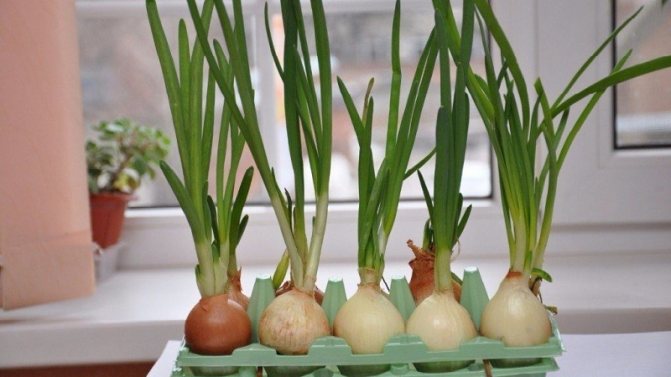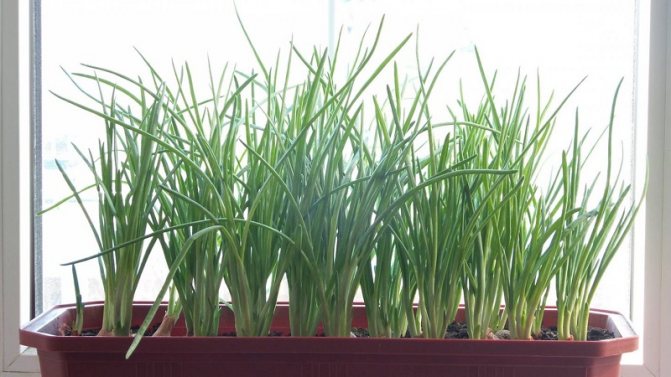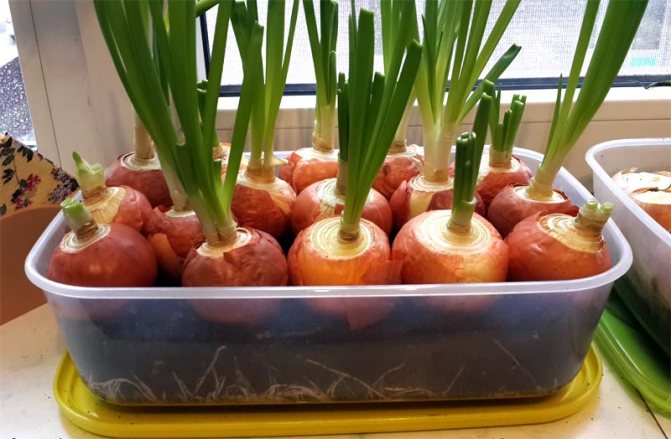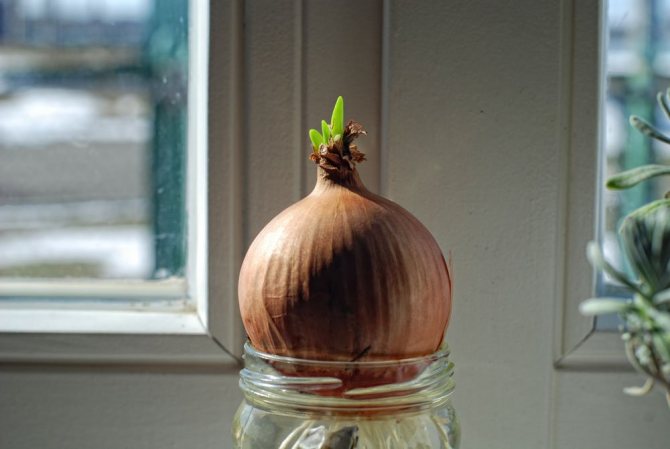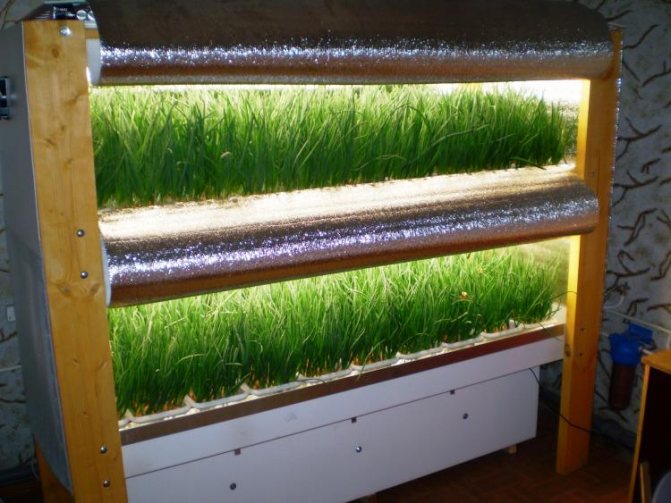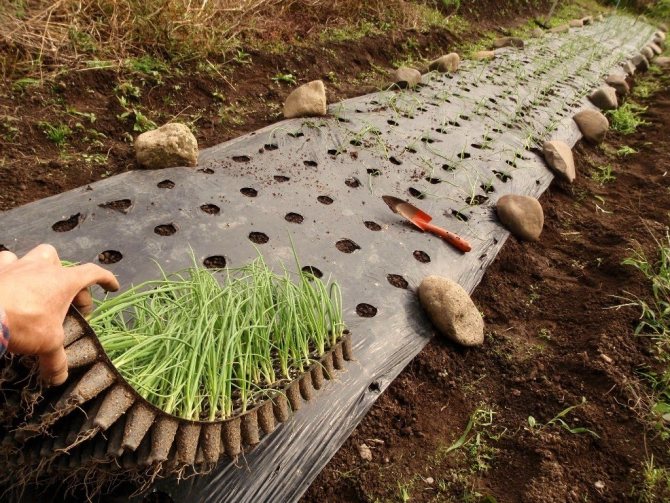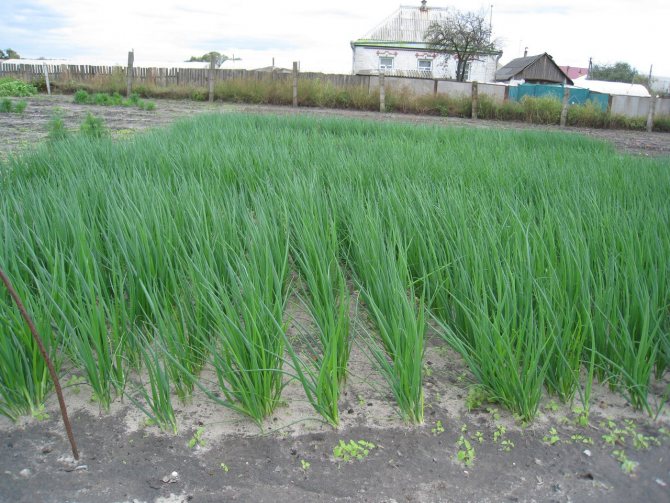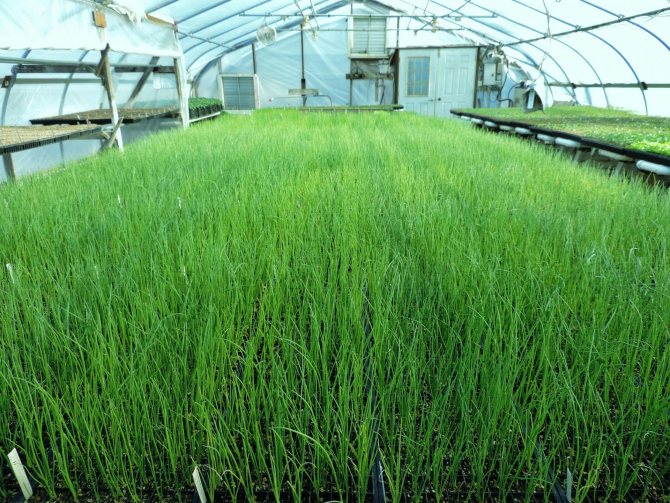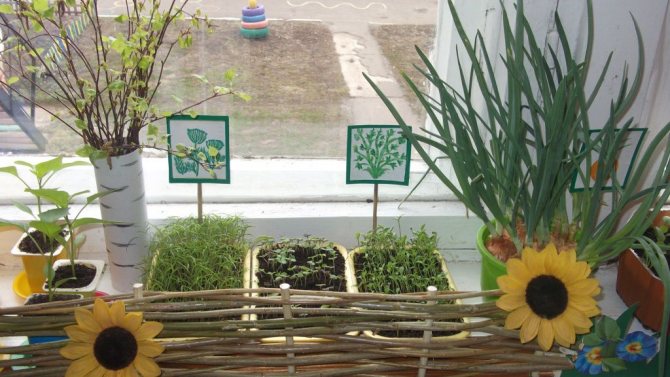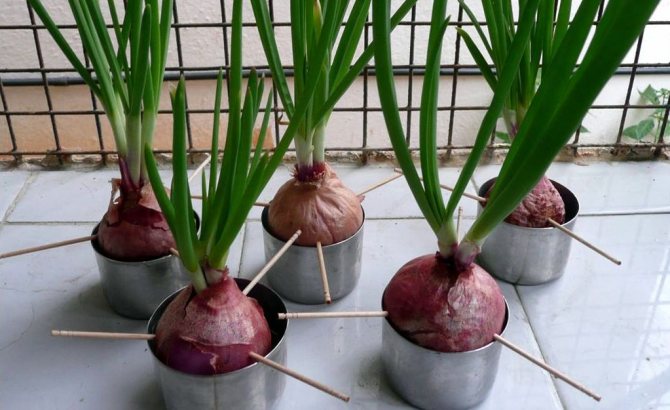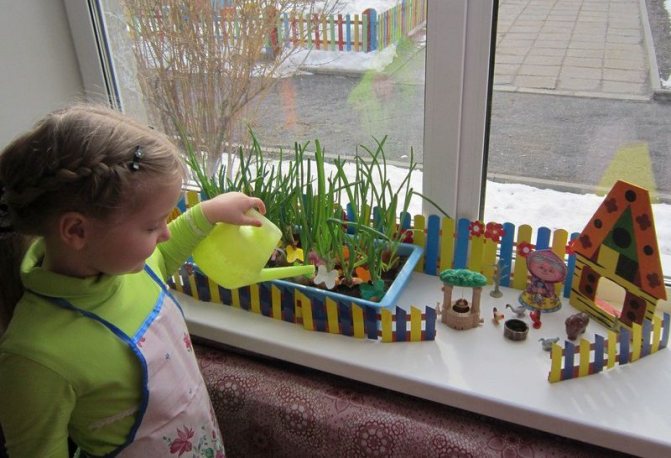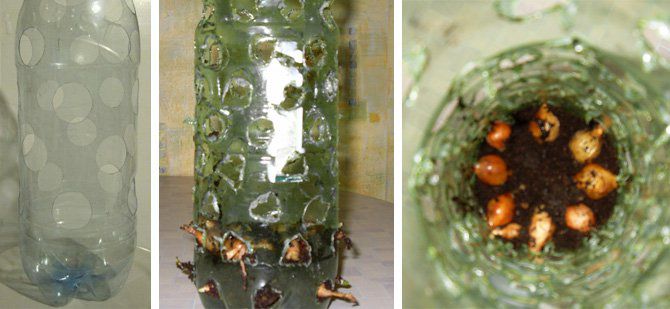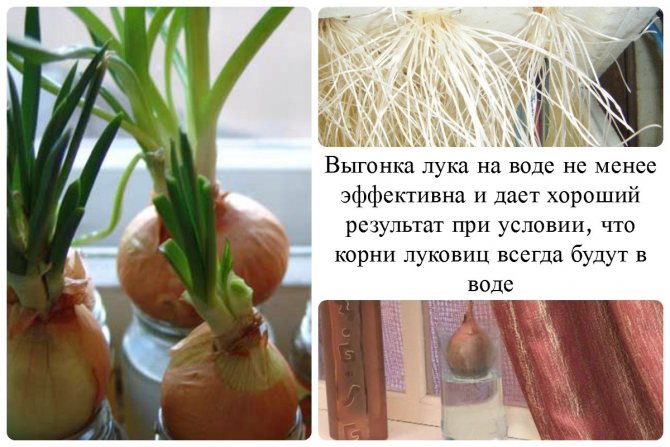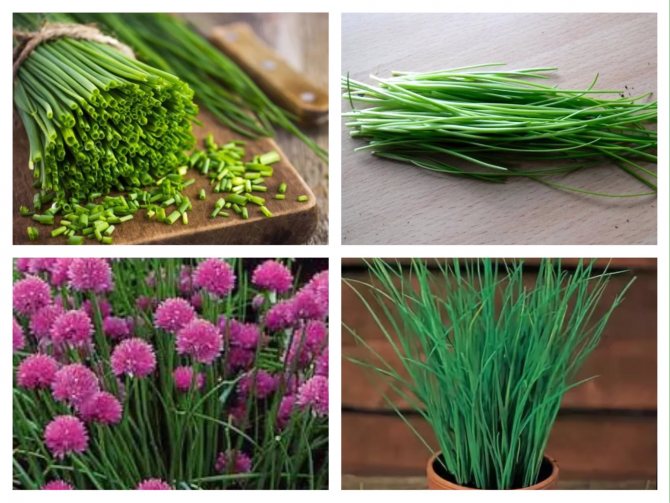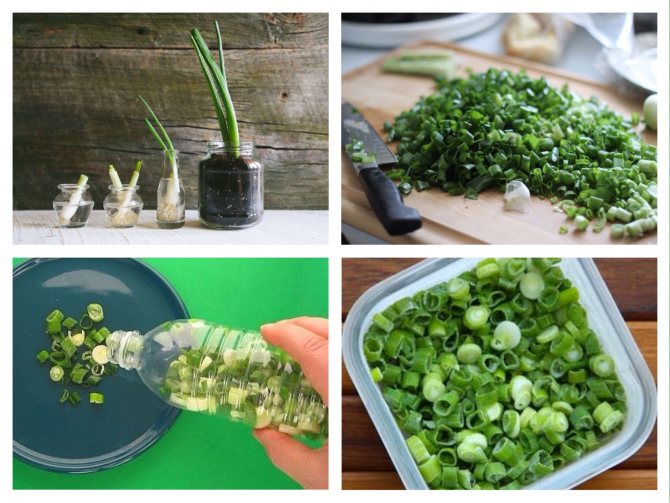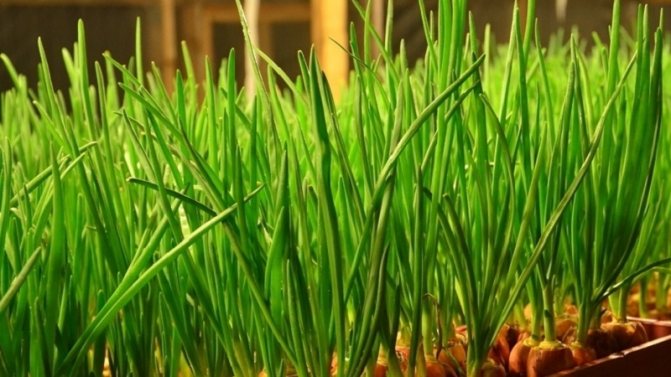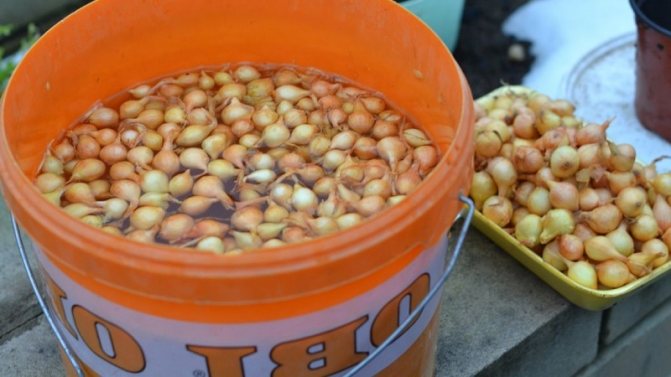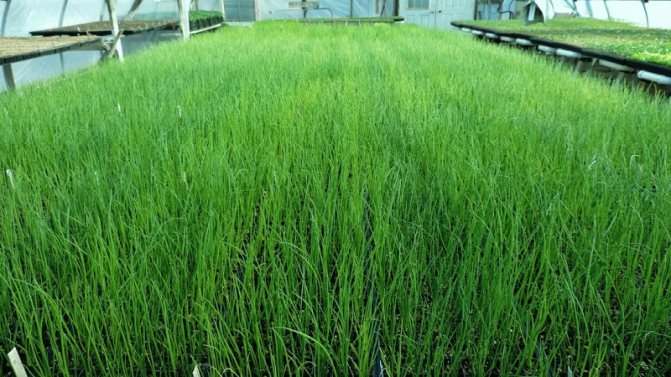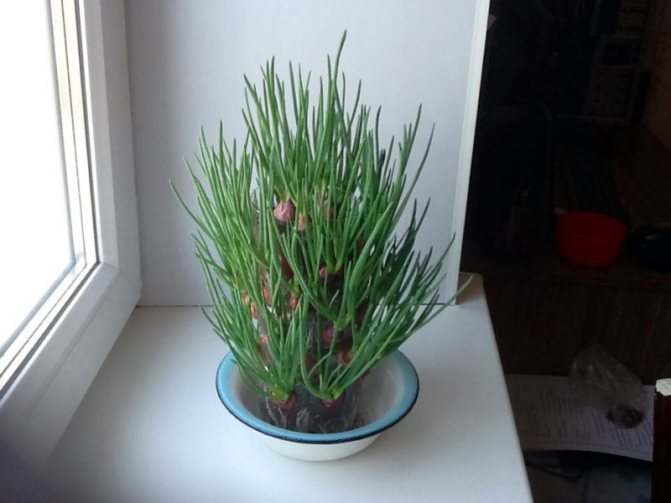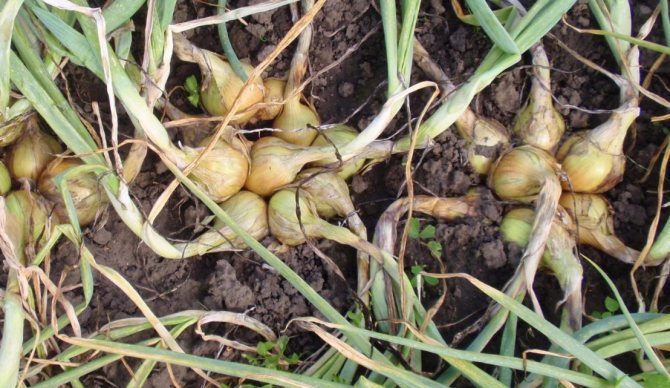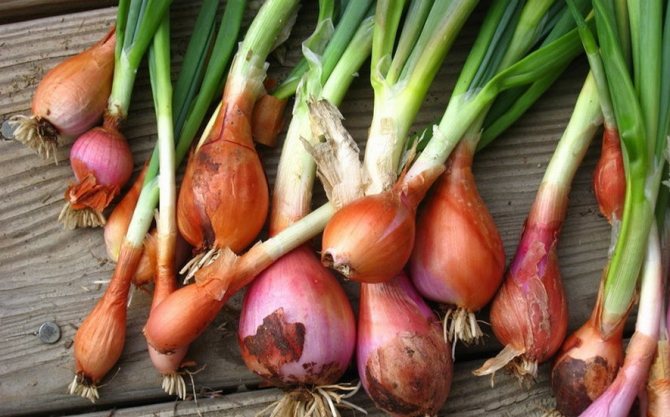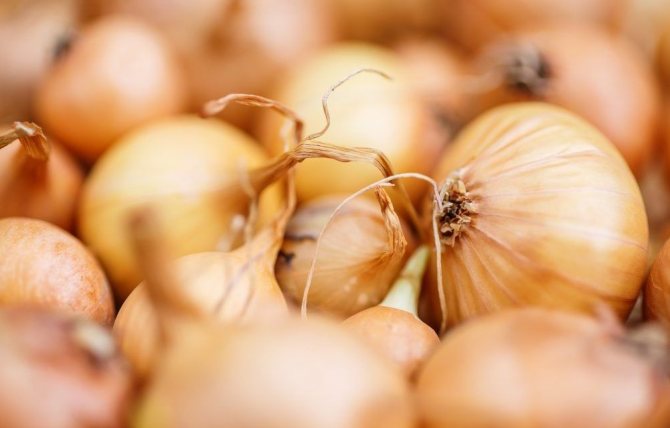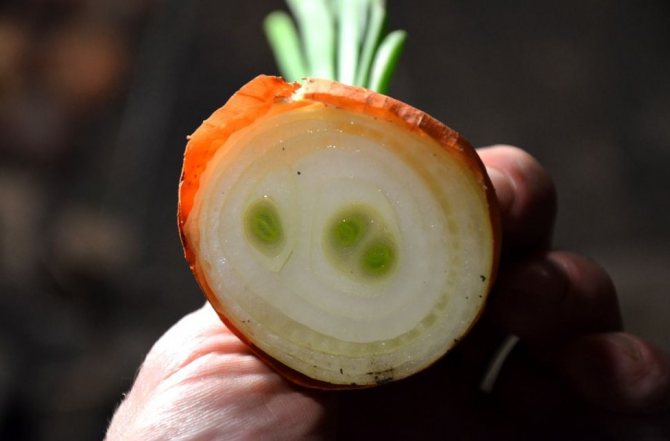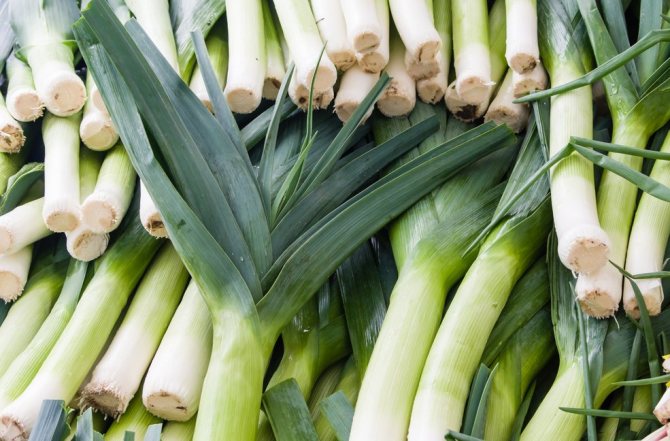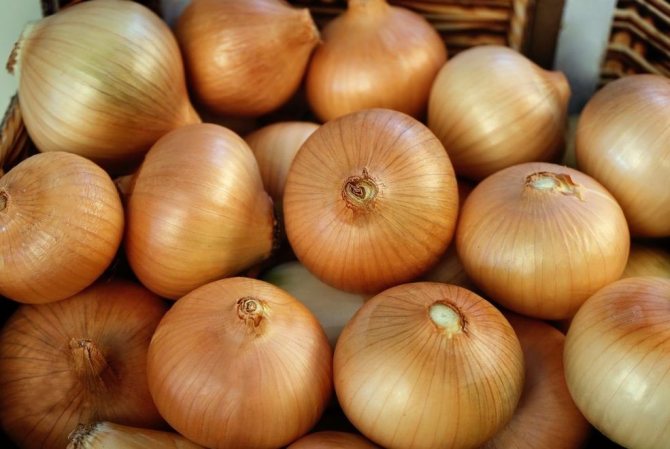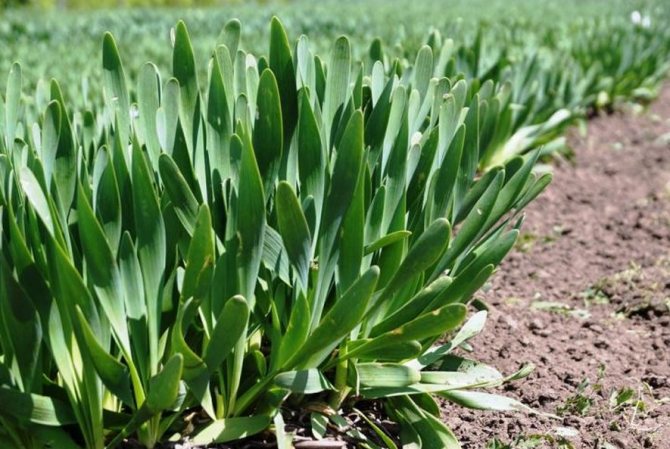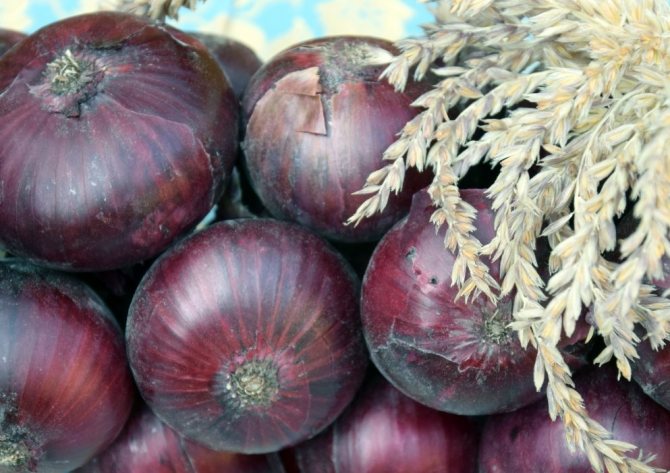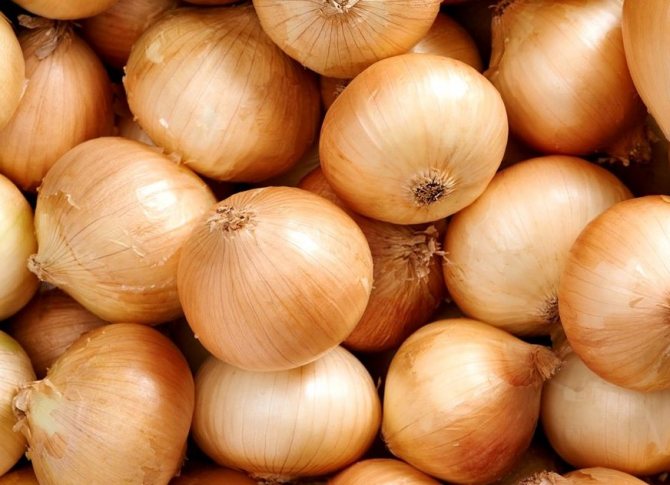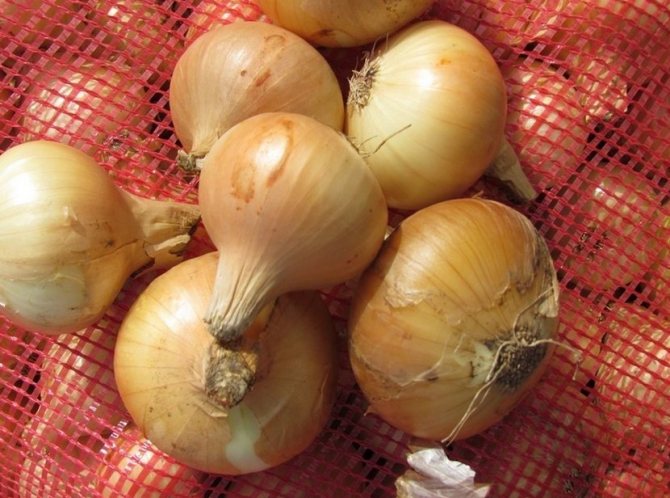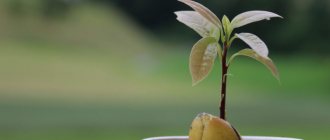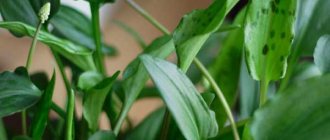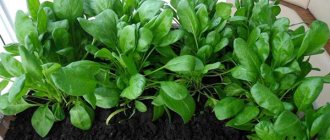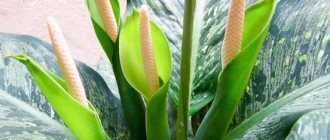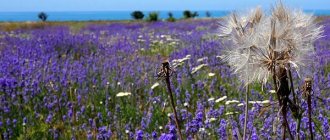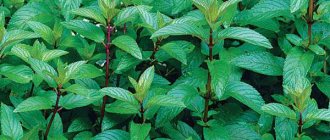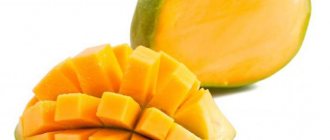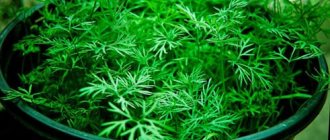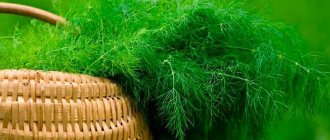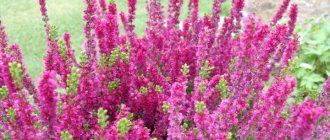- Lady lovely
- Home, family, children
As far as I remember, in my parents' house, onions were grown on the windowsill all year round. In winter, a fresh onion seemed especially aromatic and healthy. And its thin green feathers against the background of a snow-covered landscape outside the window reminded of spring. In the summer, there was no need to wait for the onions to be brought from the dacha - fresh herbs are always at hand.
Moreover, only dad was engaged in mini-farming. He put together the boxes himself, selected the planting material and stuck the seedlings into the ground in even rows. Now dad is gone. But the onion grows on the windowsill. Under the supervision of mom.
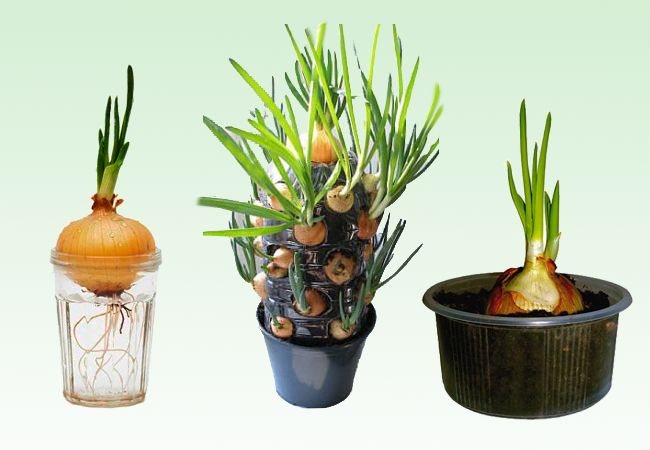
Having moved out from my parents, I also decided to continue the tradition. But I didn't have land, and there were no boxes either. I only had onions and a desire to garden. I thought there must be some clever way to grow onions without land or bulky containers. And I was surprised to learn that there are several such methods.
Onions on a feather at home: the secrets and subtleties of growing
How to grow a bow on a feather at home
? It is especially easy to grow onions on the windowsill in winter, when we lack vitamins and want fresh herbs on the table.
Consider the traditional method of growing onions in trays of soil on a windowsill.
This is an easy method for growing onions on a feather. The main thing is to provide plants with all the necessary conditions for normal growth.
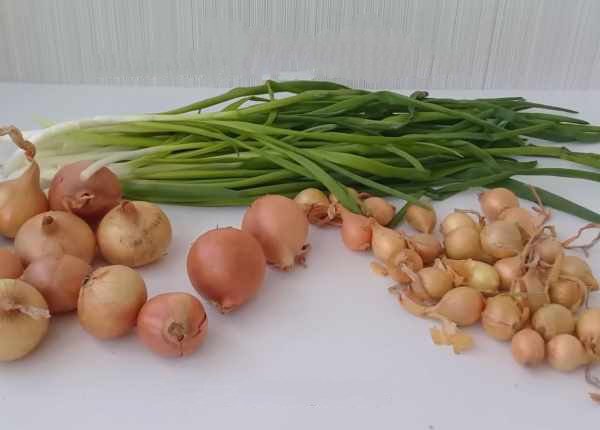

First, you need to correctly select the planting material. To compare the harvest, we will plant onion sets and larger bulbs
.
The bulbs should be round, firm to the touch, with golden scales, no rot, and hairy roots.
Before planting, it is necessary to soak the planting material for 30 minutes in warm water. Moisture contributes to the quickest awakening of dried roots. Then dry the onions a little.
To accelerate the exit of the green pen, you need cut the onion head
parallel to the root bottom. You do not need to touch the roots.
Pour soil into boxes for seedlings, it should be nutritious, friable and crumbly. Moisten the soil with warm water. Make sure to drain well so the water doesn't stagnate. Excess moisture
- this is the enemy of all bulbous.
When the bulbs and boxes of soil are ready, you can start planting.
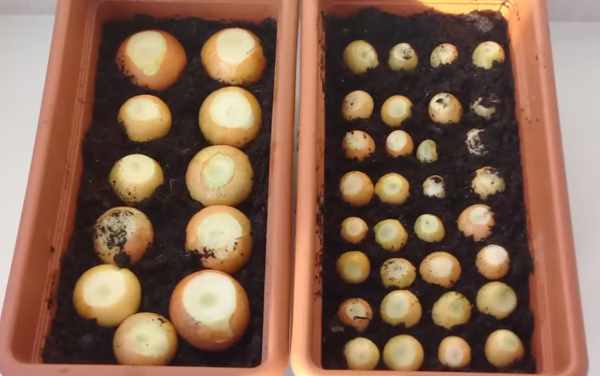

Bulbs
drowning a little in the ground, lay out next to each other. There is no need to maintain special parameters, since this onion is planted exclusively for greenery. Finally, water the onion plantings a little.
You do not need to put pots of onions on the windowsill right away. First, place the onions in a cool, dark place for 3 days so that the bulbs quickly begin to form a root system.
Video - Onions on a feather - the secrets of a good harvest!
Onion
- the culture is cold-resistant, therefore the optimum growing temperature is 18-20 degrees. If you raise the temperature to 24 degrees, you can speed up the forcing of the feather.
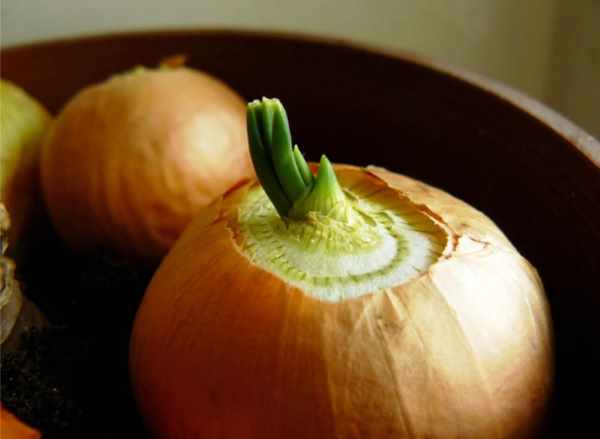

With further care during cultivation, onions require as much light as possible, so you should light up the landing
... The longer the light is on, the faster you will get your harvest. From a lack of light, onion feathers will turn yellow and wither.
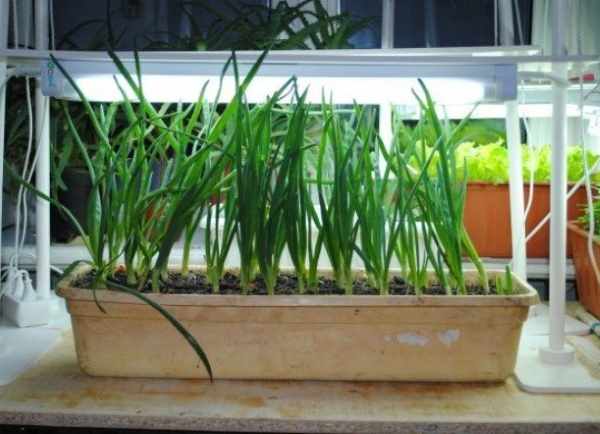

Onion seedlings need to be looked after in the same way as indoor flowers. Watering should be done in moderation, as moisture evaporates, excess moisture can cause root rot.
2 weeks after planting, you will have a harvest of onion feathers. Larger bulbs produce a richer crop than onion sets.
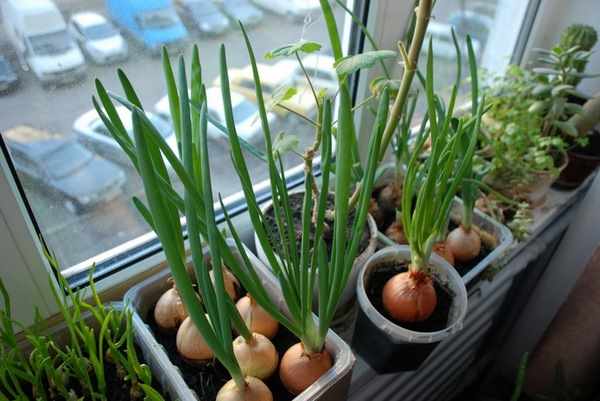

Landing time onions on a feather
does not exist, that is, it can be planted all year round. The main thing is that there is enough light.
For continuous production of greens, plant onions in different boxes at intervals of 10-12 days.
Such home grown onions
environmentally friendly, without impurities and additives, and will bring a whole range of vitamins to the table.
Video - Onions on a feather in 15 days!
What can be planted
You can grow onions on a windowsill from several planting materials:
- the bulb is a versatile material, suitable for planting in water, cactus, earth and a bag;
- part of the onion is also a good option, 3-5 centimeter stems of leeks are actively used;
- young bulbs - the main rule is to choose high-quality bulbs, without damage, mold and rot;
- seeds - onions from seeds on the windowsill are no worse than from onions. Suitable for growing in soil, but it is important to follow all germination rules.
How to grow green onions on a feather at home
Getting vitamins with your own hands throughout the year is within the power of anyone. You need to make very little effort, and the green onion feather will be on the table.
Of course, you don't have to bother too much, at present, many chain stores will offer vitamin feathers. But the onion grown at home is always tastier.
I will share some secrets with readers on how to grow green onions. It is not difficult to repeat, children especially like to participate in this process.
They will be able to be responsible for obtaining the vitamin harvest in the family on a permanent basis. You need to imagine all the care of plants in the form of a game. My son and I were organizing a competition whose feathers would be larger and juicier.
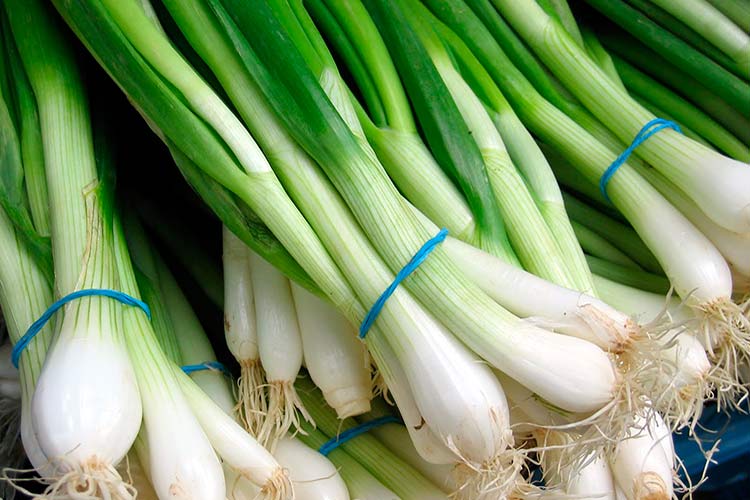

Diseases and pests
The most dangerous pests of green onions are the bulbous root mite and the western hidden proboscis. It is possible to detect a root mite due to its tiny size only by traces of its vital activity. Infected bulbs are covered with brown dust, their bottom is thinned, and subsequently disappears, such a bulb does not give roots.
The larynx can be identified by the larvae that bite into the leaves and they become visible in the light. The larvae feed on the sap of the plant, and then leave them, going into the soil, where black beetles appear, which also survive on the green of the onion.
Onion fly, hoverfly and nematode are considered less common, but no less dangerous pests.
It is unlikely that it will be possible to cope with parasites without the use of powerful insecticidal agents; severely affected plants will have to be destroyed altogether. Processing of garden tools will not be superfluous.
Among the common diseases of green onions, downy mildew and neck rot are distinguished, the main culprit of which is considered to be excessive watering and low air temperature.
Leeks often suffer from rust, which manifests itself as orange spots on the leaves. The spots gradually turn black, and the leaves dry out rapidly.
As a preventive measure for the occurrence of such problems, it is recommended to carefully observe the agrotechnical conditions and crop rotation.
The benefits of green onions
The sailors were the first to know the benefits of green onions. They had to be away from the coast for long months. They had to eat corned beef, which was stored in barrels. But they didn't know about vitamins. Therefore, many sailors suffered from scurvy.
Already at the beginning of the 19th century, ships, setting off on a long voyage, were picking up the bulbs. They were eaten. Along the way, each cook had a little space where he grew a feather. Each crew member on the ship received one arrow every day. Diseases due to lack of vitamins have been forgotten.
Also, polar explorers, being in harsh conditions, have long learned that greens will help them get valuable vitamins during long polar nights.
What makes green onions different from other plant species?
- In addition to vitamin C, other beneficial substances are present in fresh herbs. They save a person from vitamin deficiency. Symptoms that indicate a dysfunctional state disappear: loss of strength, persistent drowsiness, fatigue and dizziness when suddenly getting up from a place.
- The presence of green feathers in the diet (consumed without preliminary preparation or in salads) improves digestion, strengthens the heart and vascular system. Potassium helps, its onion assimilates from the soil mixture on which it was grown. Doctors say that lovers of these spicy herbs are not afraid of cholesterol.
- Chlorophyll, which is present in fresh shoots, promotes hematopoiesis, saves from anemia. A person's mood rises due to the good condition of the cardiovascular system.
- Oral cavity disinfection, teeth health improvement. Onions take calcium from the soil and release it during digestion.
- It has been noticed that onion lovers do not complain about the presence of stones in the gallbladder. The constituent substances serve as bile solvents, removing excess from the body.
- There is a particularly valuable substance in the composition of greens: quercetin. It serves as a prevention against the development of cancer cells. Peoples who traditionally consume excessive amounts of onion suffer significantly less from cancer.
- Beneficial substances are mainly concentrated in the thick white part. But chlorophyll is located in the green arrows. Along the way, the greens themselves are good for the digestive system.
Read also: High tops of potatoes: what to do, good or bad
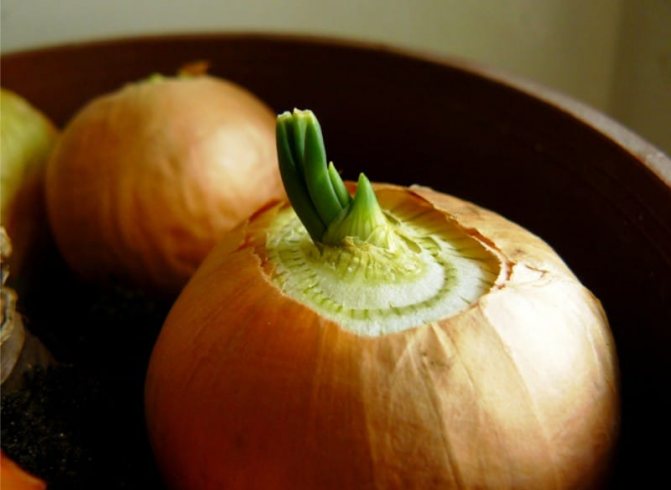

Harvesting and storage
The calendar dates for harvesting depend on the characteristics of each type and variety of green onions, as well as the methods of their cultivation.
The day before collecting greens, the beds are watered abundantly. The bulbs are cut at the root and carefully cleaned of the remnants of the earth. Next, you need to get rid of the turnip itself. To do this, cut off the root bottom and pull out the feathers. This method will help to preserve the juicy white leg of the onion as much as possible, as opposed to simply cutting the bunch. Finally, remove the brown protective film from the leg. The easiest cleaning method is to remove the film along with the first sheet. After that, the greens are ready for consumption and storage.
In the refrigerator, green onions retain their freshness for no more than 7-10 days. For longer storage, it is recommended to freeze greens. Before sending it to the freezer, it is washed well, dried, cut and packaged in containers. Defrosting and re-freezing greens is not permissible, therefore, the containers for storing onions in the freezer should be small. You can use the harvest packed in this way for cooking hot dishes throughout the winter.
Where to grow onions for a feather
For forcing onions, use flat-bottomed dishes:
- seedling boxes are on sale. They are made of plastics that are not afraid of moisture. The height of the sides varies from 2 ... 3 to 10 ... 12 cm. It is most convenient to use boxes with low sides. The most convenient height is 4… 6 cm, it is enough for the substrate and for placing the bulbs;
- disposable plastic containers for cakes, salads, halva and other products are quite convenient. She has a sufficient height, plastic is not afraid of moisture and can be repeatedly used for growing onions and other types of green mass;
- plastic bags are the most affordable material. Many vegetable growers get excellent onion arrows in them.
Preparing dishes for growing green onions
Before using it, it is advisable to decontaminate. A variety of methods are used here.
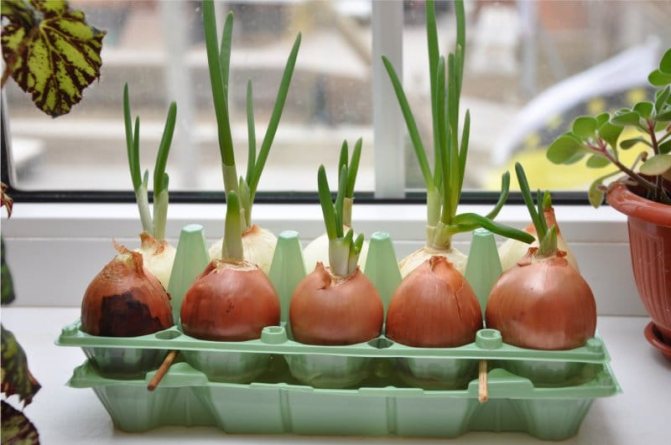

Disinfection with solutions
The easiest way is to treat with disinfectant solutions. They are prepared just before use. The dishes are washed, and then the final rinsing is carried out under running cold water.
Treatment with potassium permanganate consists in the fact that several grains are dissolved in a liter jar and a dark burgundy solution is obtained. It is poured into a bowl and kept for at least 20 ... 30 minutes.
The remains are poured into another container, and the one that has been treated is washed with a stream of water. Allow residual moisture to drain. Do not wipe it off and let it dry on its own.
Copper sulfate (copper sulfate) is used for processing. 0.5 g of the drug is dissolved in 1 l of water. It is enough to rinse the dishes with this solution, then rinse in a stream of liquid.
Some gardeners soak a tampon in a solution, wipe the walls and bottom of the dishes. A few seconds and the forcing bowl is ready.
Acetic acid with a strength of 5 ... 6% copes well with all types of infection. It is enough to wash the container, and then rinse it with an acidic solution to disinfect suitable dishes. All that remains is to rinse off the residue to eliminate the smell.
Alkalis: baking soda, slaked lime, caustic soda and others are excellent disinfectants. It is enough to prepare a solution with a concentration of 5 ... 7% and rinse the dishes with it to get rid of fungi and other infections. Then it remains only to wash off the remnants of the solutions.
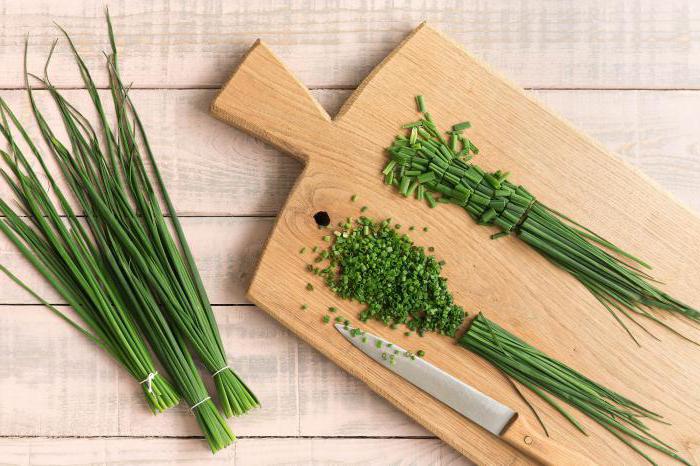

Beam treatment
Exposure for 5 ... 7 minutes under the influence of ultraviolet radiation (conventional medical disinfectant lamps). Processing should be carried out after washing off the contamination. The method is simple.
Attention! Exposure under ultraviolet rays can burn your eyes, so work should be done with sunglasses.
Forcing - off-season work
The pleasant specificity of the onion is such that it is so unpretentious that it sometimes manages to throw feathers even where it would seem that there are no acceptable conditions for this, apparently taking all the nutrients from the bulb and directing them to the feathers.
It's no exaggeration to say that forcing onions is the best and easiest way to grow onions quickly on your windowsill. The essence of distillation is that plants grow and develop at an unusual time for themselves, when, in general, there is nothing to do in the open air. You have a wonderful opportunity to grow onions under your daily supervision and have them at hand at any time of the year.
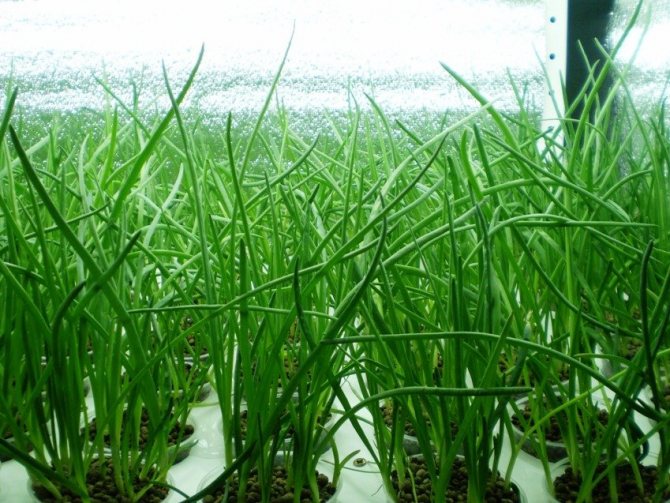

First of all, what is the best material for distillation? It just so happens that the most suitable material for planting is onions, which are best bought at the end of the gardening season in the market or in the store. Of course, you can buy at other times, but onions bought in the fall are much more likely to give feathers. Moreover, it has practically just come from the garden and has not been stored for a long time pending purchase. The purchased bulbs are brought home and dried, after which they are folded into bags or nets made of breathable material. These bags must be dry.
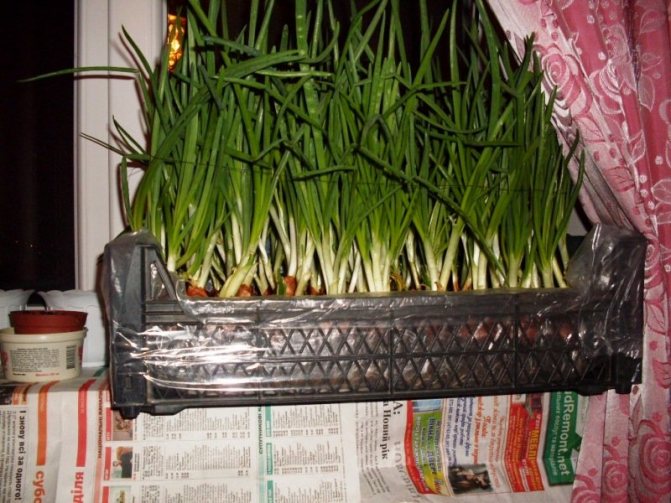

It is not difficult to choose a container. The main thing is that it should be high enough - 5-7 cm in height to fit quite large bulbs there. The width of the container is already your personal preference, depending on the desired number of feathers grown. If you stock up on two containers, you can grow onions in a conveyor way.
It is also easy to find the land for onions - it can be either soil mixture from a store, or fine expanded clay or gravel, sand or even water.
Substrate for forcing onions for herbs
For growing onions on a feather, use:
- low-lying peat, this substrate retains moisture and can give it to plant roots;
- hardwood sawdust or small shavings. Before use, they must be disinfected, spores of fungi and mold may accumulate;
- humus or leaf compost is an excellent substrate;
- perlite or expanded clay is used by many gardeners.
The substrate is soaked in water, grains of potassium permanganate are added. The pale pink solution is a nutrient medium for growing greens. You can add several granules of nitrogen fertilizers, superphosphate and potassium nitrate.
Excess moisture is removed from the substrate before use. It should be slightly damp to the touch, then root decay will not occur.
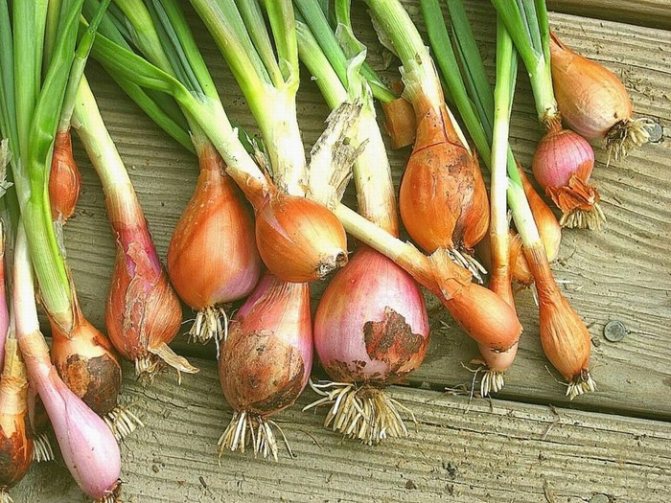

Landing
For seedlings, onion seeds are sown 1.5-2 months before planting plants in the garden. For this, the seedling boxes are filled with a loose and nutritious substrate, in which grooves are laid at a distance of 10 cm from each other. Seeds are spread into these beards to a depth of 1.5-2 cm, and then they are carefully sprinkled with earth and moistened. The seeds are germinated at a temperature of 22-25 ° C under a film or in a greenhouse. After the emergence of seedlings, the greenhouse is removed, the seedlings are thinned out, and the boxes are rearranged to the most luminous place.
Seedling care is reduced to moderate but regular watering, which is gradually reduced 15-20 days before the onions are planted in the ground. Seedlings are planted on the garden bed in the second half of April. By this time, each plant should have at least 3-4 full-fledged strong leaves. The growing beds should not be in the lowlands. A large amount of melt water will negatively affect the harvest and can cause various fungal diseases.
If the sowing of seeds is carried out in open ground, then it is worth starting this procedure not earlier than the beginning of May. 2 weeks before planting, humus or compost is applied to the garden, then it is carefully dug up and loosened. The rest of the planting is carried out according to the same principles as when growing by seedlings.
Sevok is planted on pre-prepared beds according to the 5x15 scheme to a depth of 2-3 cm.In open ground, planting is carried out at the beginning of May, but if it is supposed to use a greenhouse for cultivation, you can start sowing already in early April, but after sowing the land is additionally insulated. spreading a layer of peat on top.
The best neighbors for green onions are various types of cabbage, carrots, and tomatoes. Growing these greens next to beans, peas and beets is considered an unfortunate neighborhood.
Planting material
Throughout the year, onion sets are sold in the shops of the Semena chain, as well as similar ones. Any of the sorts exposed for implementation can be used to get arrows. The best results are obtained on varieties: Strigunovsky, Stuttgarter, Sevastopol violet, Belgorodsky acute.
It is desirable that the diameter of the planted turnips be 1.8 ... 2.6 mm. More is possible, but then fewer plants will grow in a limited area.
The bulbs must be disinfected before planting. They are kept for 60 ... 90 minutes in a slightly pink solution of potassium permanganate.
Step-by-step guide to growing onion sets in plastic containers on sawdust
The tips of the bulbs must be cut off. Then the points of growth are activated. The arrows buried inside the turnip will move up faster.
The cut is made with a sharp knife, it is advisable to perform it in one motion, so as not to crease the surface near the cut zone.
Sawdust and small shavings are poured into a gauze bag. It is immersed in warm water with a volume of 3 liters, where are dissolved:
- 0.3 ... 0.4 g of urea;
- 0.4 ... 0.5 g of superphosphate;
- 0.2 ... 0.3 g of potassium nitrate.
Read also: Watermelon Bonta F1: description, photos, reviews
After soaking for 10 ... 15 minutes, the substrate is lightly squeezed out and laid out in plastic containers with a layer of 2.0 ... 2.5 cm. Prepared bulbs are leveled and laid out.
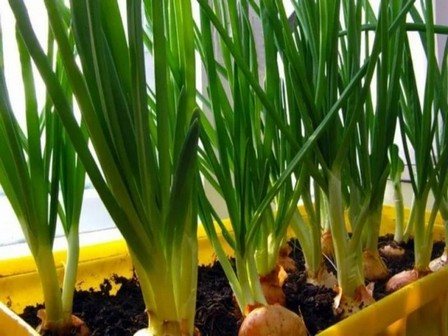

It remains to put the container in a cool place with a temperature of 15 ... 17 ° C for 7 ... 10 days. During this time, the bulbs will sprout.
After the expiration of the specified period, the containers are placed on the windowsill or in other places where the duration of illumination is at least 14 hours a day. If the duration of daylight hours is less, then with the help of phytolamps, additional illumination is performed.
After 20 ... 25 days after planting, you can cut the feathers of the onion and use it for food. New arrows will form at the cuts.
Watering should be done with caution, the substrate should be slightly damp. An abundance of water is not needed, the excess is drained after watering. Spraying with clean water can be carried out, moistening the green mass.
Planting onion sets in plastic bags
A small amount of green arrows can be obtained in pouches. A wet substrate is poured at the bottom. Onions cut from the top are laid out in it.
Experienced gardeners fill the bag with air. Lean towards it and exhale the air with their mouths directly inward. A high concentration of carbon dioxide will stimulate faster feather growth. I tie the bag on top.
The planted bulbs are sent to a cool, dark place. It is desirable that the temperature is 15 ... 17 ° C, then germination will proceed at an optimal rate.
After 5 ... 7 days, the bags with plants are examined. During this time, a rather powerful root system is formed inside.
Plants can be placed on a windowsill or in a warm, lit place. It is necessary to untie the ties so that the plants can gain access to air and lighting.
Varieties
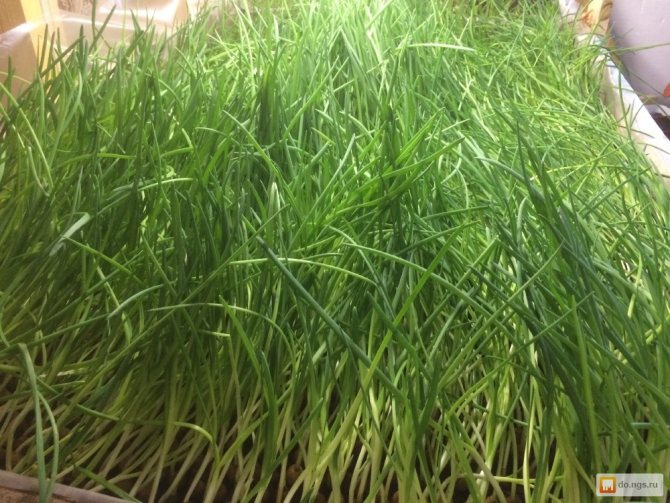

You need to choose the right varieties
In order to get a good harvest, you need to choose the right varieties and types of onions per feather. Batun (winter, sandy) shows good results. He is able to give 2-3 pastures of greenery per season.
Onions on greens in a greenhouse in spring
The Schnitt-lukili variety is also popular. It is characterized by producing narrow yet aromatic greens. Leaves can reach a height of 0.5 m. Particular attention should be paid to the fact that this species makes special requirements for the timeliness of agrotechnical measures - watering and weeding, and good lighting must also be provided.
On a note. It is recommended to plant the multi-tiered variety (Canadian) for a good harvest of onions on feathers.
It is distinguished by high frost resistance and unpretentiousness to the surrounding conditions. Suitable for off-season forcing or windowsill cultivation.
If the question arises, which onion is better to plant on fragrant greens, then it is recommended to pay attention to Leek. This variety is distinguished by wide, succulent leaves. The ready-to-eat product will delight you with its delicate taste. Features - a feather is visually similar to a garlic one; instead of a standard bulb, a thick white bulbous stem will form.
You can also choose onions for herbs and different varieties of perennials - Slizun, Shallot. All of them are frost-resistant, quite unpretentious, which makes it possible to plant before winter, in the spring you can get the first harvest of greenery immediately after the snow melts. Indicators on taste are pleasant, there is no characteristic bitterness. These varieties are good for salads.
In 90% of cases, experienced gardeners prefer to plant multi-root varieties on greens. They form 4-5 leaves each, which ensures a dense harvest.
Interesting. In order to check the quality of the seed, it is recommended to cut a small onion in half. After that, you need to consider the number of primordia and their distance from each other.
To obtain greenery, it is recommended to plant varieties such as:
- Chebotarsky.
- Rostov.
- Ryazansky.
- Danilovsky.
- Strigunovsky.
- Spassky.
- Amber.
- Siberian.
- Sprint.
- Black Prince.
On a note. In greenhouses for which polycarbonate is used, the varieties Soyuz, Bessonovsky and Arzamassky grow well.
They are planted in the winter.
Preparing onions for planting
Before planting onions on greens on the windowsill, it is important to properly prepare for this.
For forcing greens, you will need an ordinary medium-sized turnip, no more than 2 cm in a circle. To grow onions at home, bulbs need strong, undamaged bulbs. They must first be treated to prevent the development of bacteria.
To do this, prepare a weak solution of potassium permanganate (potassium permanganate) and place the bulbs in it for a quarter of an hour. After this procedure, the bulbs are kept in warm water for about 24 hours to stimulate growth. You can add fertilizer, ash (about 1 tablespoon per liter of water) or one ampoule of Epin to the water.
After feeding, the bulbs will have enough energy until the end of the growing season, in addition, they themselves contain many nutrients and are able to produce nutritious and healthy greens on their own.
Preparatory work
For the year-round cultivation of vitamin greens, first of all, it is necessary to choose the right varieties and hybrids. Strict adherence to agricultural technology and soil fertility is of no small importance. Planting onions in greenhouses begins in October in wooden or plastic boxes, which can be stacked on top of each other.
After a two-week period, they are taken out and installed in greenhouses, where further forcing is carried out. Agro-technical economics in onion cultivation is based on the correct and timely preparation of the material for planting.
Ways to grow onions on a feather
Anyone, even a novice housewife, can easily grow green onions in her apartment. And it will always be fresh, full of vitamins and delicious. One has only to get acquainted with some simple rules for growing onions on a feather at home.
Method of forcing onions the pen is simple, affordable and effective. This requires only a jar of water, an onion is placed in it, which after a while gives tasty feathers.
But there are some points that should not be repeated. Upon contact with water, the bulb quickly rots, emits an unpleasant odor, attracts midges, and the onion grows poorly and turns yellow. All window sills free of indoor plants are usually filled with these jars.
Landing in the water
When everything is ready, you can start planting. This method is suitable if you need to grow a little greenery (for example, to decorate dishes):
- Remove excess top layers.
- Trim the top of the onion and some pulp, about 0.5 cm, but if the bulbs are larger, you can trim more. If the bulb is already germinated, you do not need to trim anything.
- Place the prepared turnip in a container of water so that only the lowest part is immersed, where the roots are formed. You cannot wet the onion itself.
- Change water approximately once in two to three days to avoid spoilage and drying out, and rinse the roots under running water.
- Place the containers on the windowsill and wait for the harvest.
If you need to provide yourself and your family with enough vitamin greens, this method will not work. For plentiful forcing of onions, you can use a special device - hydroponics. The convenience of this device is compact, and the onion bears fruit for a long time and does not deteriorate due to aeration. The only question here is the availability of funds for the purchase of the device.
You can make a device for effectively distilling a green feather with your own hands from improvised means.
To do this, you need plastic egg nets:
- Cut the container into two parts along the fold of the lid.
- At the top, cut off the bottoms in each egg niche, eggs are placed.
- Collect water in the lower part and place wooden sticks on top. This will provide space between the water and the bulb.
- Place the top on them and place the turnip. The roots themselves will reach the water (of course, the distance should be minimal).
- The water must be changed in a timely manner.
Read also: Early strawberry varieties: photos and names
There is another way to plant onions on the windowsill if you need a lot of greenery. You can even organize home production:
- You will need wide containers of suitable depth on the basis that the turnip will be submerged in water by one third.
- Put the onions tightly one to the other, pour water over them. The root crop in this version will give its full potential and very quickly expel a lot of vitamin feathers.
- Add a crushed activated carbon tablet to the water. This will prevent the turnip from rotting.
Rooting in the ground
When there is no time or opportunity to monitor the water level and its freshness, it is recommended to make real beds with earth on the windowsill.
To grow green onions at home, you need to find suitable containers so that it is convenient to place them on the windowsill and provide the desired depth.
You can grow a feather:
- in the soil from the garden;
- in soil purchased for vegetables or flowers;
- in sawdust soaked in fertilizer;
- in vermicompost;
- in expanded clay;
- in peat;
- mixtures of earth and sand.
Plant the bulbs shallow, at a short distance from each other (about 2 cm).
In the bottom of the container, it is necessary to make holes to drain excess moisture, otherwise the turnip will quickly rot. If this is difficult, for example, there is no suitable pallet, then you will have to pay more attention to the rate and frequency of watering. Any sturdy box, metal, wooden, plastic or even a plastic bottle, is suitable for such a "bed".
Regularly, in a day or two you need to water the garden with warm water (it is important!). To distill green feathers, the turnip needs enough water, the soil must be moist at all times.
You cannot cut the first crop right away, because it must gain strength. You can try the feathers after 20-25 days. You need to cut off the arrows from the edge, the middle will go to the cut last.
The next batch of turnips can be planted 10 days after the first, etc. This way you can provide yourself with a continuous conveyor of tasty greens. The same onion for forcing the feather can be used for no more than two months.
Is it possible to grow from seeds
Growing onions for herbs from seeds at home is impractical. The process is too long and not worth the effort. There will be several times less greenery than when distilled from a turnip, care is very time consuming, and the window sill will be busy all the time.
If you still need to get greens in this way, then here's how to do it:
- pour small pebbles, expanded clay for drainage into suitable boxes; and fill the rest of the volume with soil;
- deepen onion seeds into the ground by 2 cm;
- gently pour over the sowing with warm water so as not to blur the top layer (it is better to use a diffuser);
- cover the box tightly with foil, place it in a warm, bright place to germinate the seeds;
- when sprouts appear, remove the film.
With this method, it is important to monitor the humidity. Drying out of the earth is unacceptable, but water should not be left in the sump either.
Optimal conditions
To delight yourself and loved ones with fresh greenery all year round, it is important to properly care for the plants and provide them with good conditions for growth.
Location
Except in some cases, when the plant needs to be kept in the dark for the first time, the onions need good daylight. Therefore, the best option would be a window sill, especially if it is on the sunny side of the house. If you have an insulated loggia, it will also do.
Lighting
Bright sunlight is needed to form good greenery. Therefore, in the dark, additional lighting may be required. The best option is a fluorescent lamp at a distance of 50-60 cm from the pot. It would be nice to leave it on around the clock, but if this is not possible, it will be enough in the evening and at night.
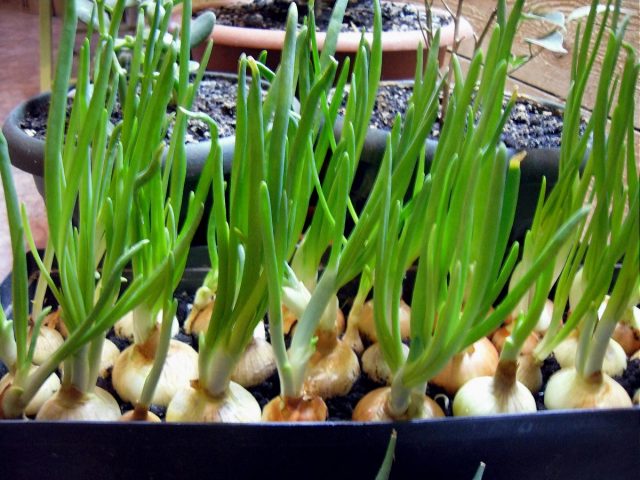

Bright sunlight is needed to form good greenery.
Temperature regime
This plant does not like heat. The ideal temperature is 18-20 degrees. And so that the container with onions does not overheat in the sun, wrap it with foil. Do not place the onion pot close to a radiator or other heat source.
Capacity
Fortunately, no special container is needed for this. You can use a flower pot, a plastic cake box, an ice cream or yogurt bucket, or whatever you have. Well, as a last resort, make a cactus onion from a large plastic bottle.
Fertilizers
The onion itself grows quickly, so it does not need any feeding. The only thing that will do him good is watering with water and diluted ash.
Care
Onion sets - the best varieties for Siberia
Culture care activities are simple. The main thing is to sow the material correctly. Further, it requires minimal maintenance.
Basic procedures:
- Watering. The pot of soil in which the onion grows is moistened every 2-4 days. Waterlogging of the soil must not be allowed. Warm, settled water is suitable for irrigation.
- The box with greens is placed on the south window. Additionally, it is recommended to install a fluorescent lamp. Only if there is enough light, you can get tasty, fleshy, fragrant feathers.
- Tearing the first feathers is not allowed. This will stop the growth of subsequent greenery.
- The plant does not need any additional feeding. The green mass receives the necessary nutrition from the bulb itself.
- If one of the heads begins to rot, it is immediately removed. Otherwise, the onion will infect the neighbors.
Step-by-step instructions for growing "onion cactus"
A new original way of forcing green onions - an invention of resourceful housewives. It allows you to free up space on the windowsill for other needs, as well as decorate the kitchen interior with the help of such "exotic".
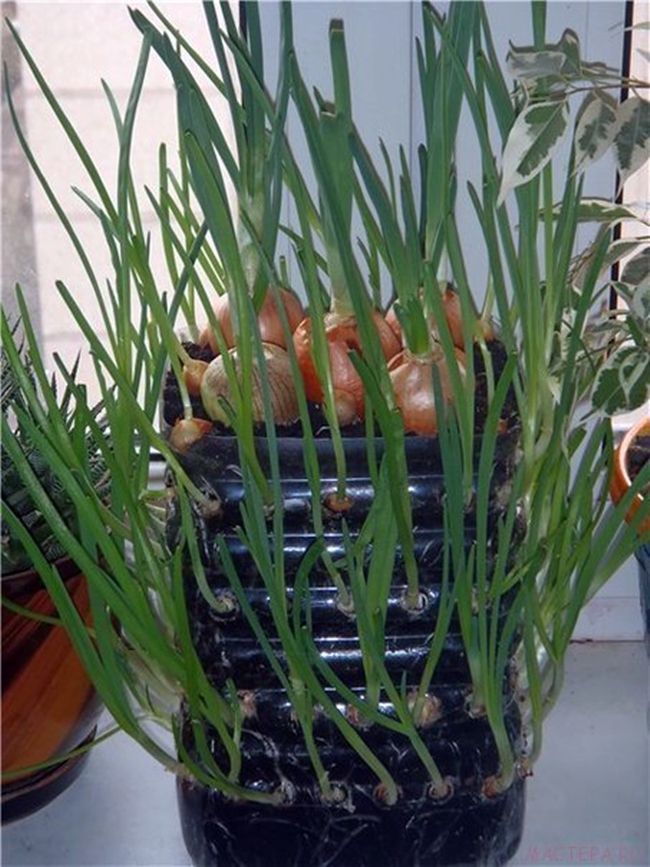

You can grow a green onion for the winter table yourself in your apartment
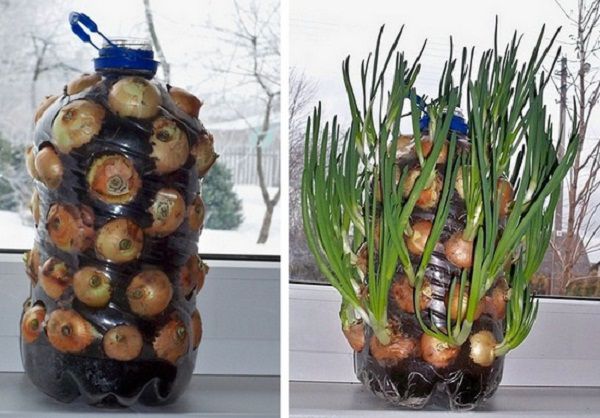

You can not cut off the top of the bottle, then small bulbs will be needed for planting.
You will need bulbs, a 5 liter plastic bottle, a sharp hole punching tool, and all-purpose primer.
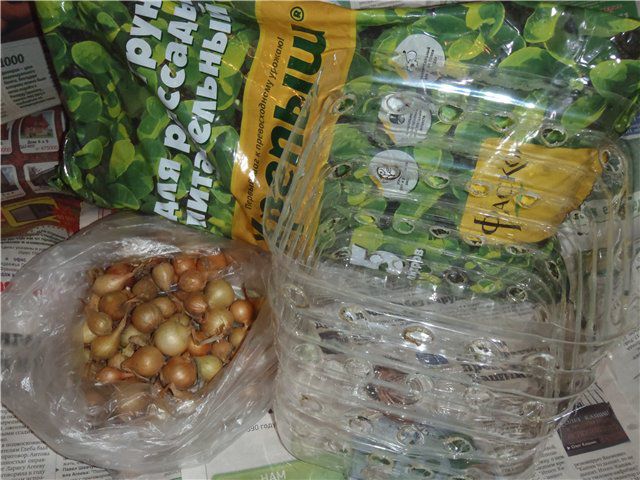

Preparing everything you need
Table. Step by step guide to planting.
| Steps, photo | Description of actions |
| A plastic bottle and a tool for cutting circles are taken (here is a heated self-tapping screw, which must be held with pliers). |
| 3-cm round holes are cut in the container. |
| The first layer of soil is poured into the container up to the holes. The bulbs are laid so that their tops go out into the holes, and the roots go deep into the jar. |
| A new layer of soil is sprinkled on top. Steps 3 and 4 are repeated until complete. |
| Several onion seedlings are planted vertically on the surface. |
The bulb arrangement should be placed on a well-lit windowsill. In order for the arrows of greenery to grow evenly, it is recommended to periodically expose different sides of the container to the sun. The rules for watering and feeding should be the same as in the general case of planting bulbs in the ground. It is only necessary to ensure that the soil does not erode.
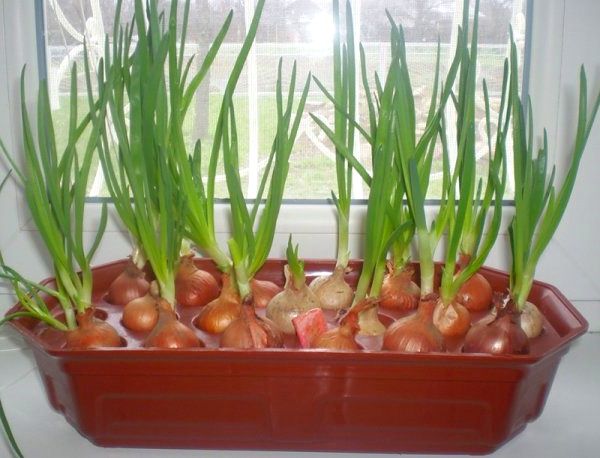

Green onions can also be grown in water
What varieties are better chased
There are certain types of onions that are chosen for feathering. First of all, the requirement for them in terms of the amount of yield at the output. For this, preference is given to multi-primordial varieties.
Rostov onion. This variety is resistant to fungal diseases, has a high yield, medium ripening time. The most common in Russia and the CIS.
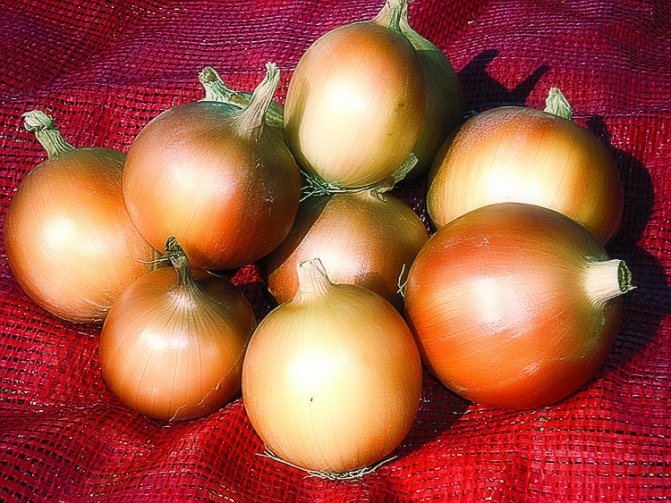

Black Prince. A multi-bud onion variety, takes root well, gives an average yield. The bulbs are suitable for long-term storage. Planting a variety on a feather is also possible from seeds.
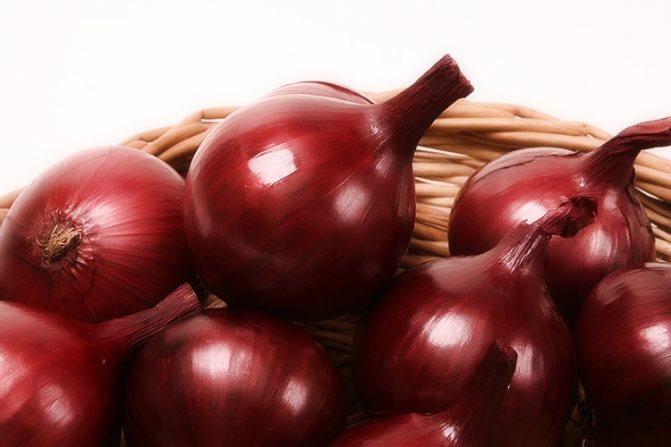

Besson's bow. Old onion variety, adapted to the Russian climate, shelf life, medium yield. Feathers of dense structure, not long.
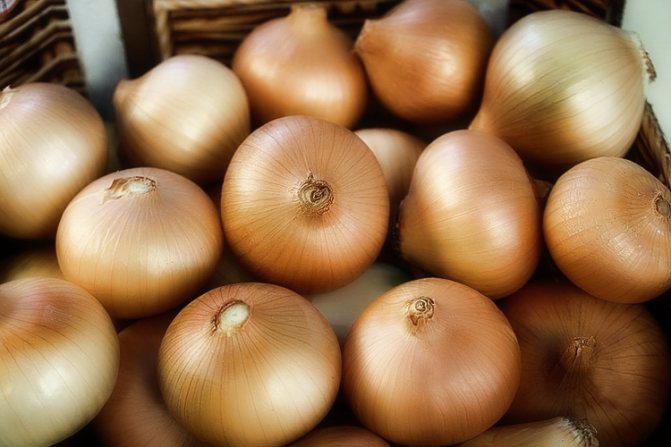

Arzamassky. One of the main varieties of onions, optimal cultivation in the non-chernozem zone. Also resistant to common diseases.
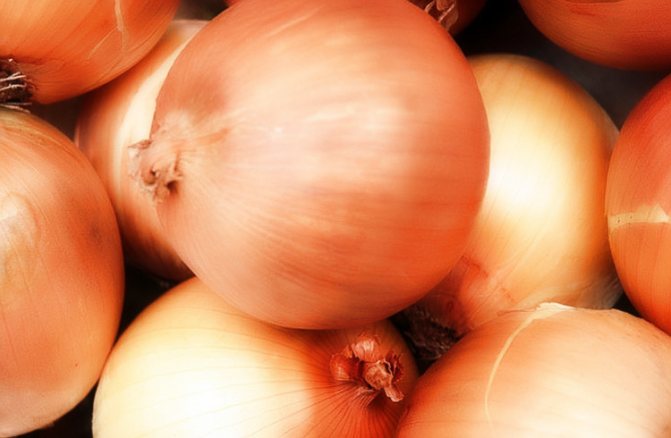

Amber. The variety gives good, thick feather straps. Has resistance to common onion diseases. Feathers reach a length of 30-35 cm.
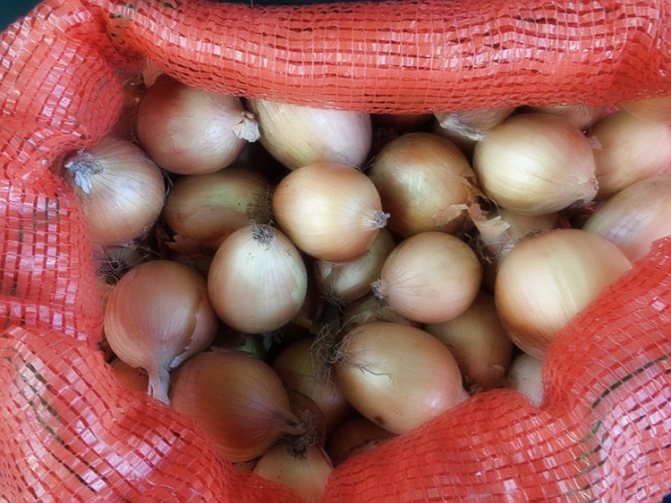

The onion is a slime. It is also called ferruginous onion, feathers are dense and thick, does not require a lot of lighting, planting in the shade is possible - this is especially important in the northern parts of the country.
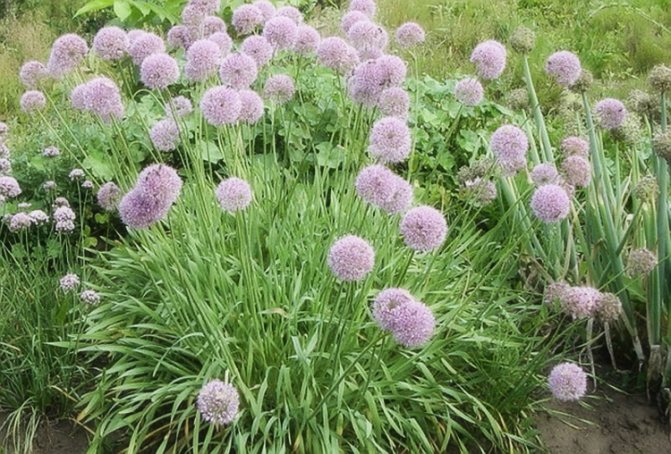

Shallot. The leaves are not prone to the formation of arrows, the feathers reach up to 40 cm.This variety is considered more useful than onions.
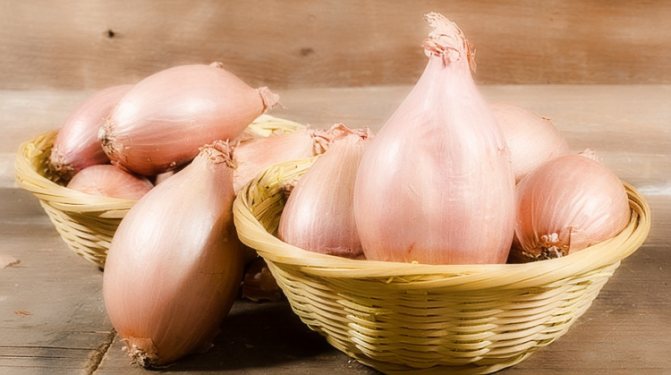

Leek. Outwardly, the leaves are similar to garlic, this variety has a delicate taste. The feathers are up to 55 cm long.
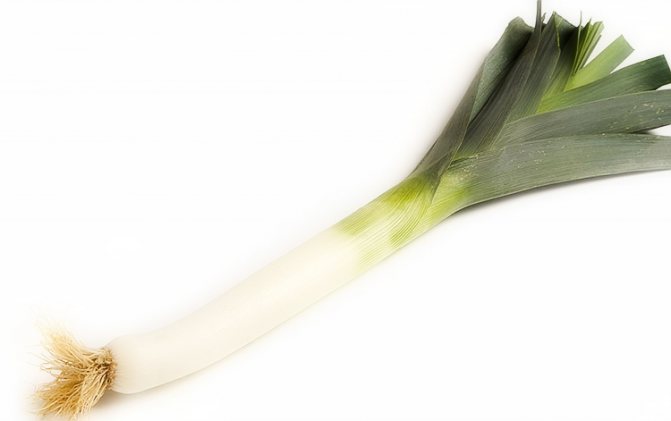

Chives bow. This variety has rather thick feathers. Chives are highly resistant to low temperatures and cold. Suitable for forcing in winter and in northern regions.
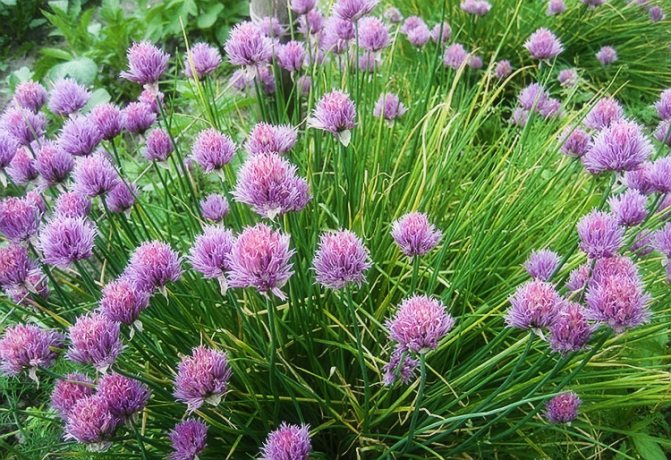

Onion. Not a whimsical variety, it takes root in almost any area with normal lighting. Onion feathers are of medium density and length.
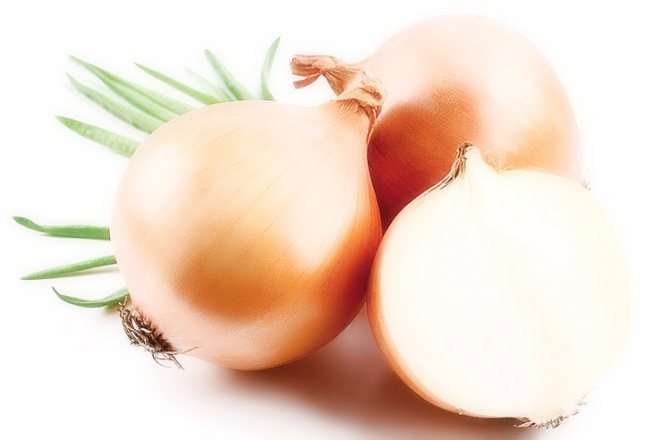

Smart solutions
The healing properties of onions make it possible to cope with vitamin deficiency and fatigue, strengthen immunity and have a beneficial effect on digestion. Green onions can of course be purchased in the store, but they cannot be compared with the one you grow yourself. Having landed it at home on your own, you can pick it up at any time, in the right amount. And you will be completely confident that the greens are grown without chemicals or harmful substances.
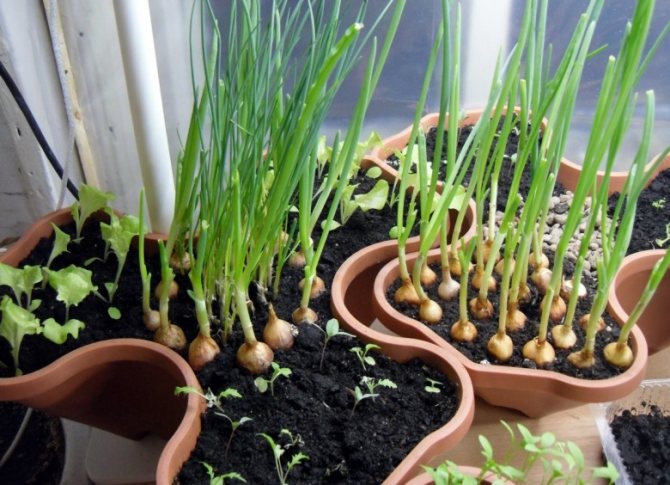

By planting green onions at home, you can pluck the required number of feathers at any time for cooking.
Self-cultivation of onions is available even for a child, but if you decide to harvest a rich harvest of greens, then you should figure out the basic planting rules and some nuances.
Harvesting
Yield is a significant factor when choosing a particular variety of onions for feathers. Although onions are not particularly picky about growing conditions, following the recommendations for each individual variety can significantly increase the yield at the output.
- Rostov onion. One of the most productive varieties. From 1 sq. meter, you can get feathers up to 4-5 kg, with rational feeding of the crop, the value can be increased up to 1.5 times. Consumption of planting material per 1 sq.m. about 10kg.
- Onions are also high-yielding varieties. From 10 kg. Bulbs are obtained up to 3.5 kg of feathers.
- Chives bow. Having spent on planting 1 kg of onions, the yield of feathers is, on average, twice as much, 2-2.5 kg of greens.
- Shallots give a yield from 1 kg. planting material up to 3 kg. greenery.
- Leek. This variety gives a yield twice as much planting material, sometimes reaching 2.5-3 times the value.
- Slime onion. 1 kg. onions of this variety give a yield of 2 to 2.5 kg in 25-30 days. greenery.
What you need to know about the conditions for growing onions at home
Cold-resistant plant, onion, unpretentious to temperature conditions. If there is insufficient light in the mini-garden, it will not be possible to naturally grow a succulent feather of a saturated green color.
For placing dishes with sprouting onions, windows facing south-west or southeast are suitable.
On clear sunny days, the midday sun should not fall on young feathers - this makes the greens coarse and turn yellow. It is advisable to shade the glass with paper or temporarily rearrange the bow in the shade.
Plants will lack sunlight on dark northern windowsills. This disadvantage can be compensated for by artificial lighting. Special phytolamps or ordinary gas-discharge fluorescent lamps have a spectrum composition similar to natural diffused solar radiation.
Lamps for additional illumination are placed above the planting level at a height of 60-70 cm. The lamps should not be kept constantly on - the plants also have a period of night sleep, and a violation of biorhythms adversely affects the growth of green mass.
Optimal conditions for growing green onions:
- temperature 23 ... 27 ° C;
- relative humidity 70 ... 85%.
Central heating dries the air - the feather grows pale and weak. To help the plants, planting onions must be sprayed daily with ordinary water from a spray bottle - the operation allows you to keep the cells filled with moisture.
Rules, secrets and tricks
Compliance with the basic rules for growing green onions without soil allows you to harvest without unnecessary hassle throughout the year. You can use additional tips on how to sprout onions on a windowsill in water:
- It is recommended to add crushed activated carbon to the germination water. You will need 2 tablets per liter of liquid. The tool will prevent the development of pathogenic bacteria.
- A clean piece of cloth can be placed in glass containers with water, so that it is slightly in contact with the bottom of the onion. The liquid will rise up the tissue, nourish the roots, while the risk of decay will be significantly reduced.
- If the liquid in the container becomes cloudy, it is recommended not only to change the water, but also to rinse the overgrown roots under the stream.
- The regrown feathers should be cut from the edge to the center, so that the greens grow evenly and the risk of damaging the onion head is minimized.
- At low air humidity, feathers can be sprayed with warm, settled water. The liquid should not get on the onion, otherwise it will start to deteriorate.
- To ensure a continuous harvest of greenery, it is necessary to plant new bulbs as soon as the feathers sprout 10-15 cm.
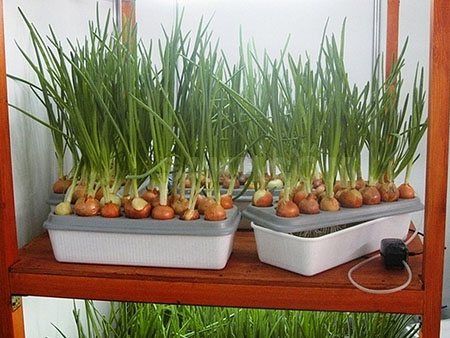

Features of feeding
Feeding onions for greens in a greenhouse includes several stages. For processing, choose mineral and natural fertilizers. Good results are obtained by alternating different feedings. When choosing top dressings, they are guided by the composition of the soil, the conditions in the greenhouse, the stage of crop growth.
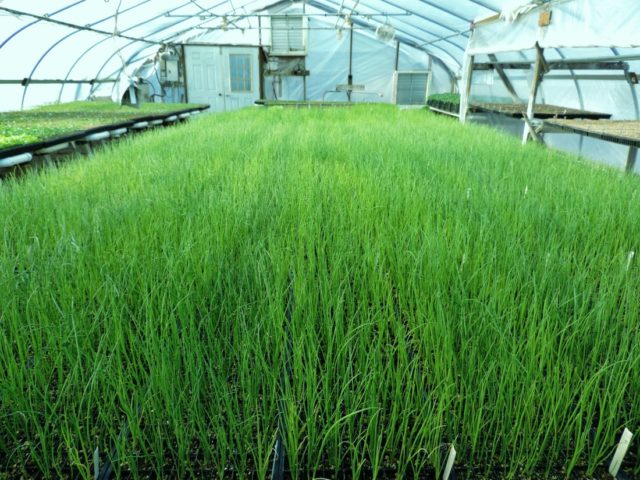

Mineral fertilizers
Minerals are added at all stages of onion development. The most important for the culture are nitrogen, phosphorus and potassium. These are the main micronutrients that support feather growth. They are found in mineral fertilizers. For feeding, different types of substances are mixed.
Attention! When working with mineral dressings, the dosages are strictly observed. An excess of substances in the soil negatively affects the quality of the shoots.
Nitrogen fertilizing provides active growth of shoots. With a lack of nitrogen, feathers lose their color, develop worse, turn yellow and fade. One of the best options is urea. The substance is in the form of white crystals that dissolve well in water.
Phosphorus is responsible for the metabolic processes in the bulb. As a result, the culture develops rapidly and produces many shoots. For distillation, superphosphate is used, which has a long-lasting effect. With a lack of this trace element, plant leaves darken and acquire a purple hue.
Potassium fertilizers for green onions help regulate water balance, accumulate sugar and starch. In addition, they increase plant immunity and disease resistance. Potassium sulfate or potassium salt is used for feeding.
On the basis of mineral fertilizers for onions on a feather, complex feeding is obtained. Add to 10 liters of water:
- 20 g of urea;
- 30 g superphosphate;
- 20 g of potassium sulfate.
The resulting solution is poured over the soil between the rows with onions. This feeding provides the culture with basic trace elements.
Organic fertilizers
Onions respond positively to the introduction of organic matter. This includes fertilizers of natural origin. They are safe for humans and the environment and are commercially available. The main disadvantage of organic matter is the inability to accurately determine the rate of trace elements that enter the soil.
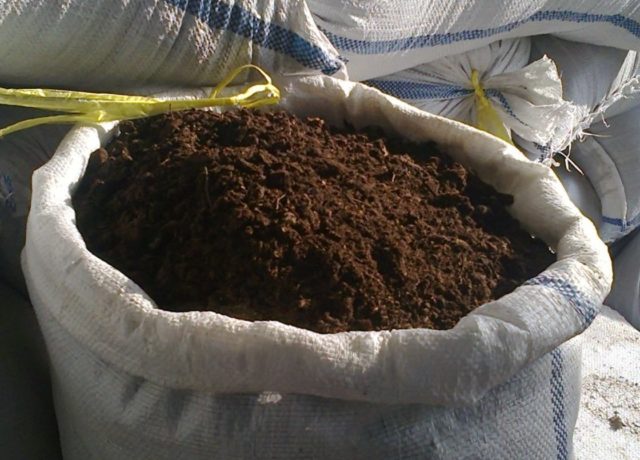

The best organic fertilizers for feeding onions on feathers:
- Humus. An effective feeding method that has a long lasting effect. It is laid in the ground before planting onions. For 1 sq. m add 5 kg of humus. It is not recommended to use fresh manure for the culture. Rotted compositions are preferred.
- Herbal infusion. The product saturates the soil with nitrogen, which promotes the growth of feathers. It is made from nettle, chamomile, clover, mustard and other weeds. The herbs are crushed and filled 2/3 of the barrel with them. Then add water and leave the product to infuse for a week. Then 10 parts of water are added to 1 part of the herbal infusion and the plantings are watered.
- Yeast. They are microscopic fungi that contain amino acids, iron and other trace elements.Yeast feeding promotes feather growth and increases plant endurance. For feeding, take 10 g of dry yeast and 5 tbsp. l. sugar, which is added to 10 liters of water. The resulting product is left warm for 3 days. Then the infusion is diluted with water 1:10 and used for irrigation.
- Wood ash. A universal option for feeding, which contains potassium, magnesium, calcium and sodium. Ash also inhibits the development of putrefactive bacteria. It is sprayed over plants or added to water before watering. Ash can be added to the soil before planting.
Important! Wood ash works well with other organic fertilizers, with the exception of manure.
Mixed fertilizers
Mixed fertilizers contain a complex of nutrients necessary for growing onions. They usually include nitrogen, phosphorus and potassium, as well as additional components. They are used at all stages of cultural development.
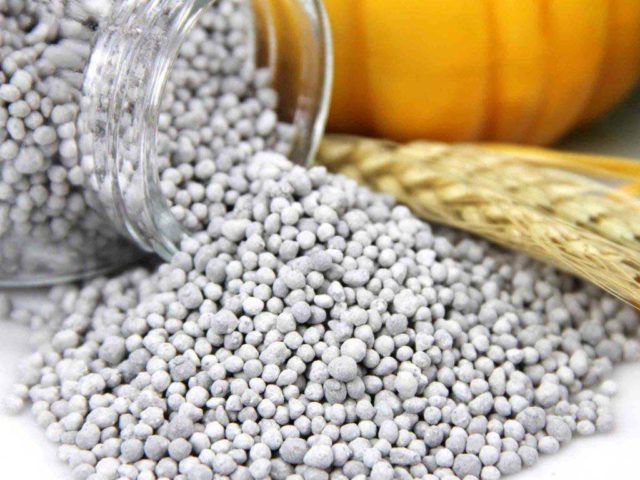

Mixed onion fertilizer options:
- Nitrofoska. A complex method of feeding in the form of granules. Consists of nitrogen, phosphorus and potassium substances. It is used for feeding onions on feathers in the early stages. To obtain a solution, 40 g of Nitrofoska per 10 liters of water are required.
- Vegeta. A preparation in liquid form that helps onions to grow green mass. Contains humates and basic trace elements. The agent is added to the water before watering. Plants are fed no more than once every 10 - 14 days.
- Effekton-O. Effective fertilizing for vegetable crops. Supplied in liquid form. The composition includes nitrogen, phosphorus and potassium substances. The drug improves soil fertility and the yield of bulbous crops.
- Agros. Complex fertilizer for onions, rich in microelements. All of them are easily absorbed by plants. As a result, the yield of onions increases, and its resistance to diseases and pests increases.
How to identify suitable bulbs for forcing
You can check the future yield of the bulb as follows: cut it across and see how many primordia for the feather are in it. The ideal number of primordia is 3 or more. The average amount is 3-5, more is quite rare.
For greens, they acquire an autumn, fresh harvest of onions, it is important that all the bulbs are dry and healthy. For forcing on a feather, take medium, 3-4 cm in diameter, bulbs weighing 30-50 g. For conveyor cultivation, you need to purchase and prepare onions in batches of different sizes, store the planting material in dark dry rooms.
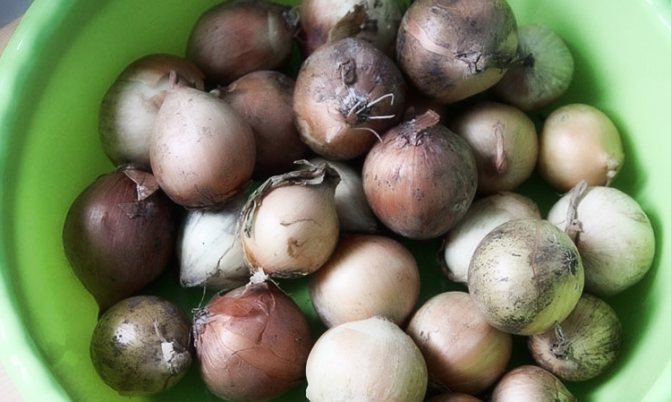

Onion care
To obtain the maximum and juicy yield of onion feathers, proper plant care is necessary.
At the planting stage, it is necessary to disinfect both the planting material and the soil, or the container in which it will be planted. To do this, use a weak solution of manganese, or copper sulfate. It is also necessary to observe a constant light and temperature regime - for growing indoors, as well as periodically ventilate them. On the open ground, caring for a plant involves loosening, the formation of a crust on the ground should not be allowed, this will significantly slow down growth.
At the same time, it is recommended to apply fertilizers - humus and complex mineral fertilizer - only three times from planting to feather cut.
It is optimal to feed the plants with artificial fertilizers at the beginning, during planting and after the first 5-7 days in a lower dosage, the last, third feeding should be carried out with a minimum amount of fertilizer.
Water the plant as needed so as to moisten the soil, preventing stagnation of water - this will lead to rotting and reproduction of pathogenic microflora and pests.
Light mode
The onion is a light-loving plant, but some of its varieties are not whimsical to lighting, and are quite suitable for growing in shady areas. For forcing on a production scale in an enclosed space, lighting can be provided with conventional fluorescent lamps. An even distribution of light must be observed.
Round-the-clock lighting will benefit the plant only in the first time, in the second half of the distillation it is necessary to reduce the lighting to 10-12 hours per day.
For home growing greenery, special lighting measures are not required, unless you install a pot or container on the window and maintain moisture.
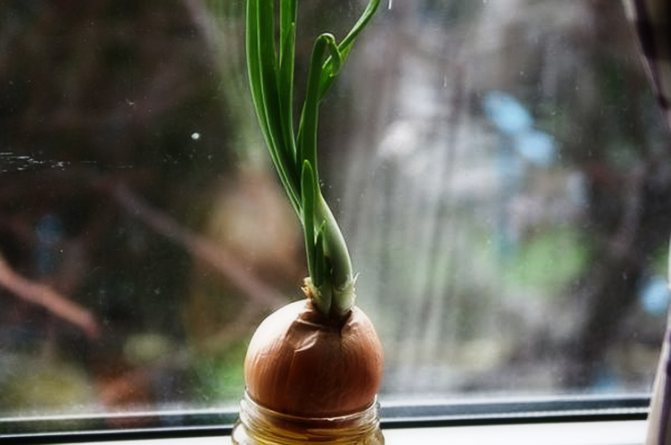

Temperature regime
It is important in forcing onions on a feather and observing the temperature regime. Since feathers are mainly grown in the period from autumn to spring, when the demand for greens increases, they are forced in greenhouse conditions with heating.
Favorable conditions for forcing onions on a feather have air temperatures from +10 to +21 degrees in the daytime, and + 10 + 15 at night. A decrease in temperature can lead to a slowdown in feather growth up to 40 days, and an excessive temperature increase can lead to a weakening and gradual withering of the culture. Observing the temperature of + 20 ... + 25 degrees, the crop can be harvested on the 22-25th day.
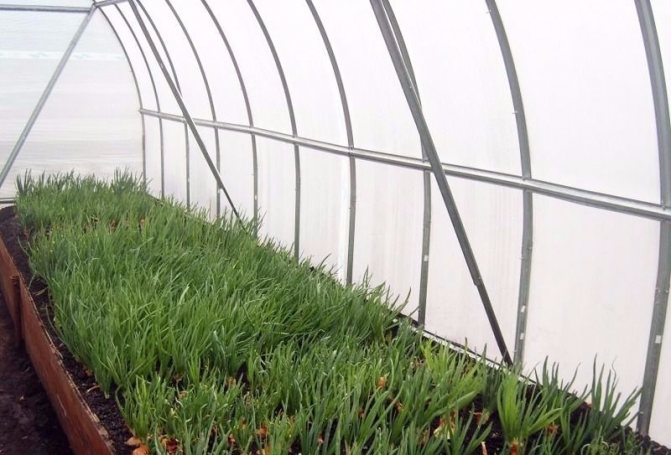

Getting started (video)
The container must first be rinsed in running water, then rinsed with a hot solution of potassium permanganate and rinsed again with water. Then soil is poured into it with a layer of 3-4 cm, and as an additional barrier in height, you can build a side made of plastic or cardboard 3-5 cm high, which is fastened with tape.
Next, take the bulbs with an average diameter of 2-3 cm. It is possible to use bulbs of other sizes, only in this case they must be the same in section, always strong, without signs of disease and not germinated. Sprouted bulbs are best planted separately, you can harvest earlier from them.
Bulbs for sowing are soaked in warm water of forty degrees, in which they are kept for a day. Central heating batteries are useful to maintain the temperature. After soaking, it is recommended to remove the top husk from the bulbs to check the quality again. If you are sure of the planting material, it is not necessary to remove the husk.
Since you probably want to get the best result, purchase bulbs of multi-primordial varieties like Spassky, Arzamas, Union, Timiryazevsky, Rostov onion and others.
The next step is to cut off the head of the bulb by a centimeter or one and a half. You can also do the following: cut the onion crosswise to a third of its depth and leave it dry for a couple of days to allow it to saturate with oxygen. This will speed up the forcing process.
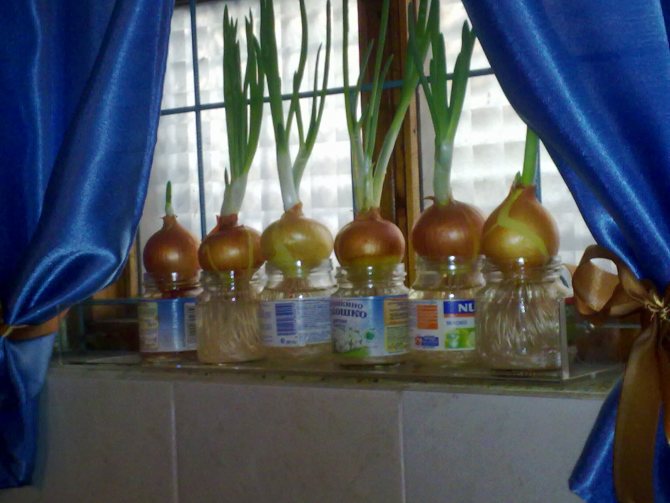

Then water at room temperature comes into play, which you pour into the pan so that it is 1-1.5 cm above the ground level. The bulbs are planted with the bottom down tightly to each other, keeping their vertical position. The container is placed in a very warm place for a week (from +25 to +28 degrees). Usually, during this time, the leaves have time to grow a couple of centimeters. At this point, the container is transferred to a place well lit by the sun or lamps. It is during this period that onions are picky about lighting, and if it is not properly provided, the feathers will inhibit development, acquire a pale shade and will not accumulate vitamins, as well as the well-known onion juiciness and aroma.
We follow the development
During the period of feather growing, the water level must be kept slightly below the substrate level so that only the roots are in it, otherwise there is a high probability that the bulbs will begin to rot.
If you want to always be with herbs, you can plant the bulbs on the second call 10-12 days after the first.
Do not expect friendly seedlings from bulbs. Of course, the onion is an unpretentious plant, but each bulb develops according to its own scenario, so it is quite possible that out of a dozen bulbs, a couple of three may lag slightly in development. But after a while, this lag will be quickly eliminated. After about three weeks, the feathers will grow 20cm in length and can be cut off. Moreover, you need to cut off the extreme leaves, since new ones will begin to grow from the middle.
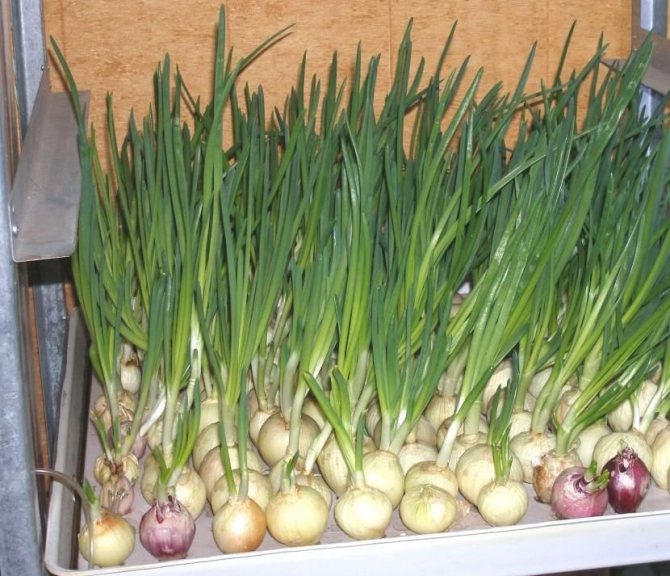

Hydroponic plant
For those who like to feast on a green onion from the garden on the windowsill in winter, special devices have been invented. They work hydroponically.
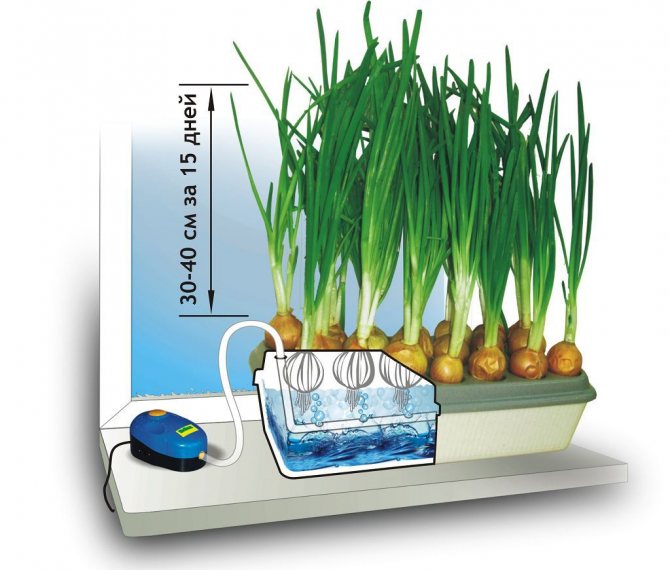

Hydroponic bed "Onion Happiness", a device for growing green onions
The box is filled with water, the bulbs are seated on top of the holes so that their lower surface hardly comes into contact with water. A special compressor forms a moisture suspension inside the container. Thus, the likelihood of root decay is excluded. It is noticed that with this method, the arrows of the bow grow much faster.
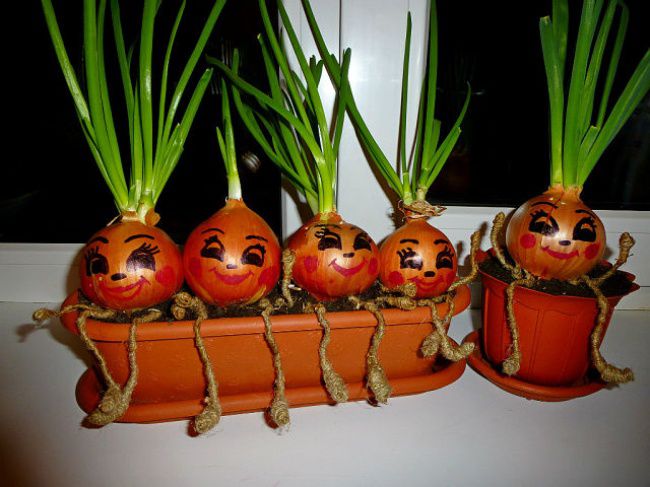

Growing green onions is not only healthy, but also convenient.
Basic rules for making dressings
When introducing substances into the soil, a few simple rules are followed. Be sure to observe the timing of fertilizing and the dosage of substances. The first treatment is carried out during the germination of bulbs or seeds, when the shoots reach 5 - 7 cm. Subsequent - with an interval of 2 - 3 weeks.
Attention! If the plants look oppressed, then additional application of substances is required.
Onions are fed in the morning or evening. The soil is preliminarily watered so that the nutrients are better absorbed. The mineral solution must not come into contact with feathers and bulbs. If this happens, the plants are watered with clean water.
For feeding green onions, minerals and organics are chosen. It is best to alternate between different types of fertilizers. When receiving working solutions, the proportions and dosages are observed. An excess of fertilizers in the soil negatively affects the development of onions, as does their lack.
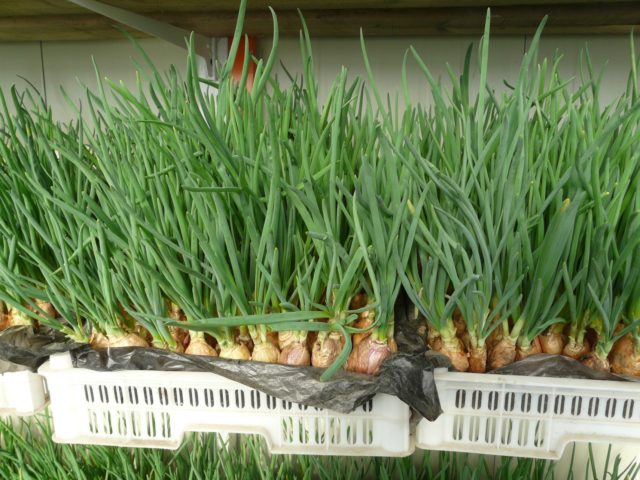

Fundamentals of agricultural technology
Onion sets are medium-sized heads ranging in size from 1 to 3 cm. Sevok is an annual product that was grown from seeds. It is from the sevka that you can get the maximum juicy greens for your home. The culture has a large number of varieties, for example, Spassky, Timiryazevsky, Bessonovsky, Carmen, Soyuz. They are all suitable for growing feathers. Sell heads in garden stores.
Planting material
Before planting onion sets at home, a decent planting material is selected. The heads should be healthy, shiny, free from defects and mold, with a smooth and even husk. Do not plant a soft product that emits a putrid or sweetish smell. A slightly sprouted set is allowed for planting.
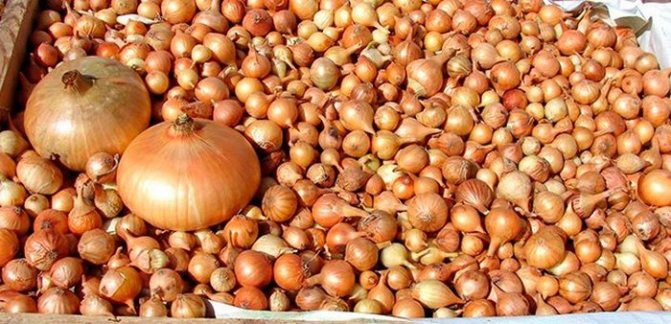

Local Bessonovsky onion variety. Preparing for landing
Composition of the earth
Onions, which are to plant a house in a container, need to create conditions close to natural conditions. The soil you need is light, neutral, breathable, with good drainage. It is allowed to purchase ready-made soil mixture at a garden outlet. Also, the owner will make it himself without any problems.
To fill the container, mix:
- 300 g of peat;
- 100 g of coarse and fine sand from the river bank;
- 100 g of humus;
- 100 g of turf;
- 100 g of ordinary garden soil.
- 50 g of ash.
The soil mixture is disinfected. To do this, it is pickled in the oven or steamed. It is recommended to add agroperlite to the substrate when mixing the ingredients. This component will make the ground lightweight and breathable.
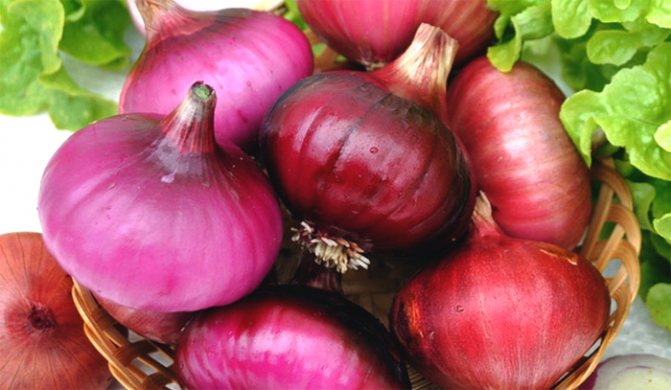

Onion variety Danilovsky
Temperature
In open ground, sowing of a culture takes place when the air warms up to +11 degrees and above. The process of plant development starts at a temperature of +18 degrees. The same characteristics should be observed when doing homework. After planting, the plastic box with the onions is removed to a cool place, in which it is about + 11 ... + 14 degrees. In such conditions, the container is kept for 10 days, then transferred to a warm room (where + 20 ... + 26 degrees), on the windowsill. It is necessary to harden the plant to increase its immunity, develop strong roots and obtain better quality raw materials.
Better not to keep the container with the plant near batteries or ovens. Too hot and dry air will destroy the sevok, its feathers will be stunted and tasteless.
Important! Growing greenery in an apartment involves frequent ventilation.This is done several times a day if there is no strong wind or snowstorm outside.
Humidity
The soil in which the heads are located must be well moistened. But you cannot fill it, as this will cause rotting or the development of fungal infections.
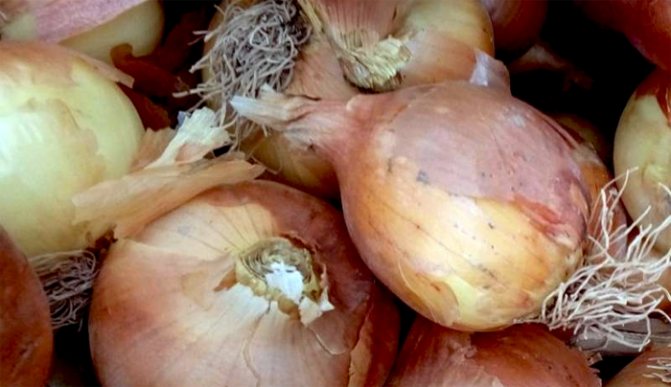

Onion variety Karatalsky
Light or shadow
Onions are a light-loving plant. In the garden, they try to plant it in open areas where there is enough sunlight. Homemade onions also need light space. If the feathers grow frail, their color is light green or whitish green, then the onion does not have enough light. In this case, additional lighting is mounted on the windowsill.
Features of winter, spring, summer and autumn distillation
In winter, it is recommended to take early ripening varieties for distillation.... Abundant watering will be harmful, as it will provoke root rot. Particular attention is paid to lighting and heating.
Spring and summer open field onion season begins... Varieties of different harvest dates are used. Planting is carried out at intervals so that the cutting of the greens is gradual. Since heating and additional lighting is not required, the cost of vegetables will be lower.
In the fall, lay the onion beds for next year and move on to greenhouse cultivation.
Reviews and comments
- Irina Very often we plant onions on a feather, from the very early spring to late autumn. It is more difficult to do this in a greenhouse, but perhaps the main thing is good lighting. And in the summer you need to choose a more shaded place. Of the different varieties, I can mention Parade, it germinates well, the seedlings are friendly, the feather is long and dense, the lower part is very small.
Nina My pets love exactly green onions (feathers) for me, but not really onions. Therefore, I always plant a lot to eat fresh and dry it for the winter. The main thing is that there is a bigger dryer and then I don’t buy greens all winter.

